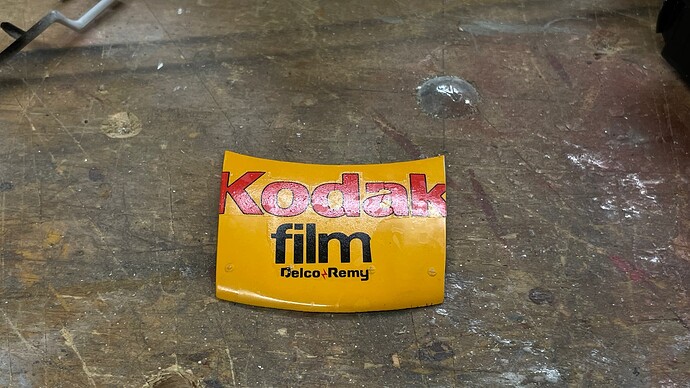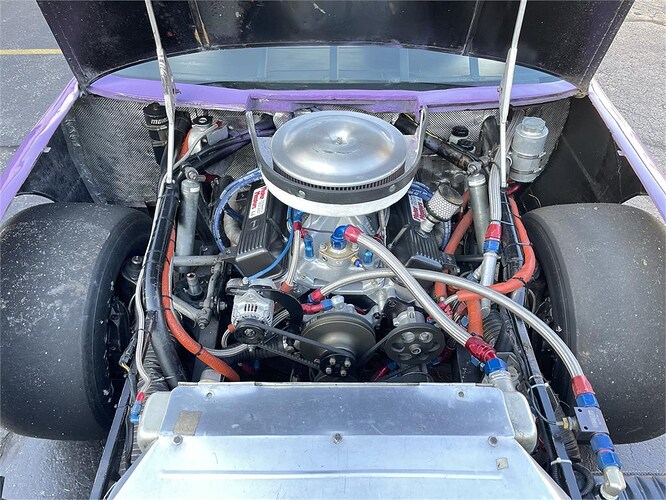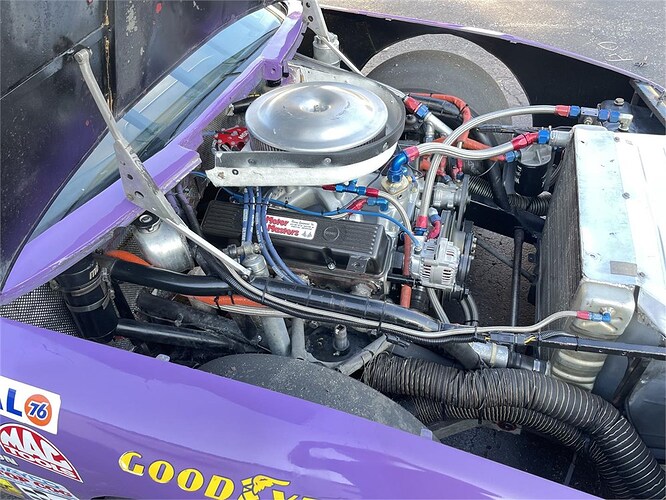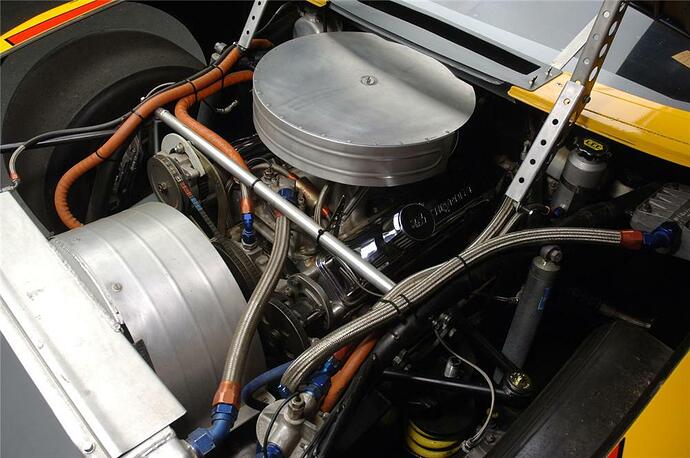Nice job building and detailing the old 1/25 scale AMT Ernie Irvin #4 Cutlass Olds. No need to be concerned with the Holley carb as it’s completely covered by the air cleaner.
From what I remember Monogram also kitted the #4 Ernie Irvan Cutlas Olds but in 1/24 scale.
joel
Happy 4th. Everyone be safe and don’t lose any body parts with fireworks. We model builders need all of our body parts intact.
Thanks! I may have used the wrong scaling factor on the carb. I used 1/24 instead of 1/25. Don’t know how much difference it would have made.
The day started with wanting to try the decals again with the laquer coating. I chose to put on the big “Kodak” on the hood, only to find that somehow, I got gloss black paint on to the final finish. Instead of attempting to remove it with solvents and destroying the underlying finish, I used Novus Plastic Polish and a lot of elbow grease and rubbed it out while mostly preserving the finish. The big decal was going to cover a lot of area so it could hide any other blemished.

Once again, the decal started splitting apart, and to make matters worse, the laquer was washing off the decal in a white film. I perservered and got the pieces to fit together.
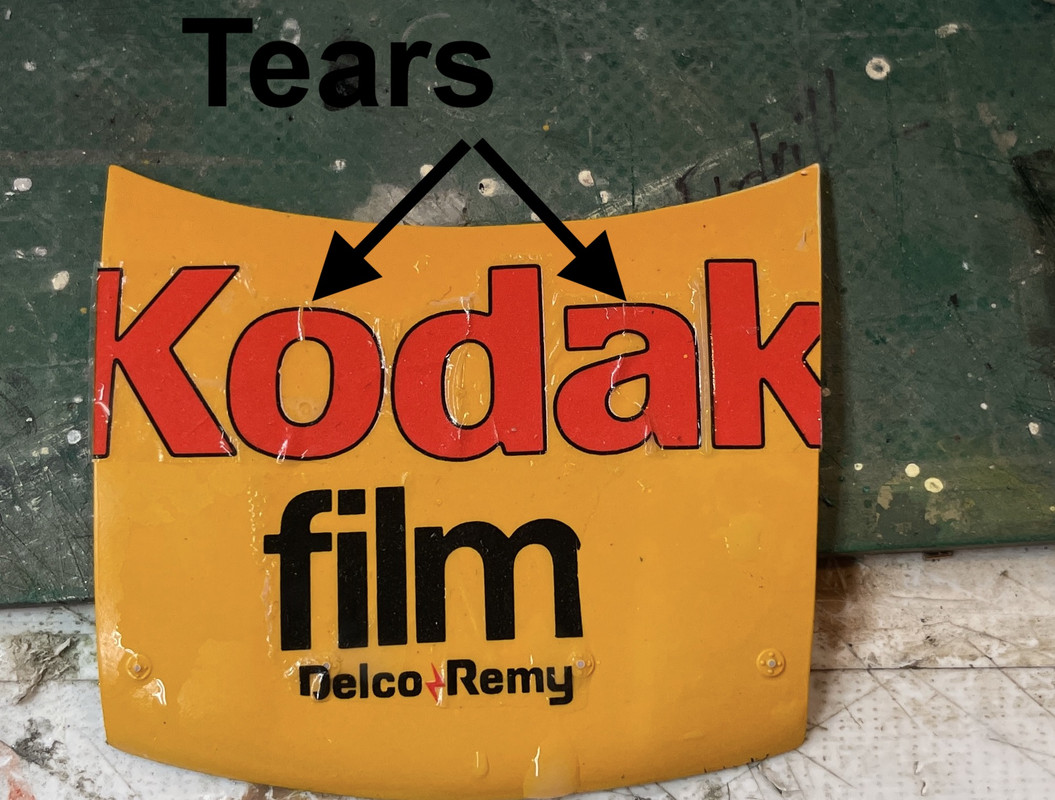
coating the decals again with Micro-Sol Decal Coating Liquid to try and prevent the breakup that I’m experiencing. I coated with Micro-Set and let it dry. The results ain’t so hot, but they may be okay after another gloss sealing coat. I don’t about you, but it makes me very unhappy to have a finish ruined by decals after spending a coupld of days laying it down.
Here’s the decal mostly cured at the session’s end.
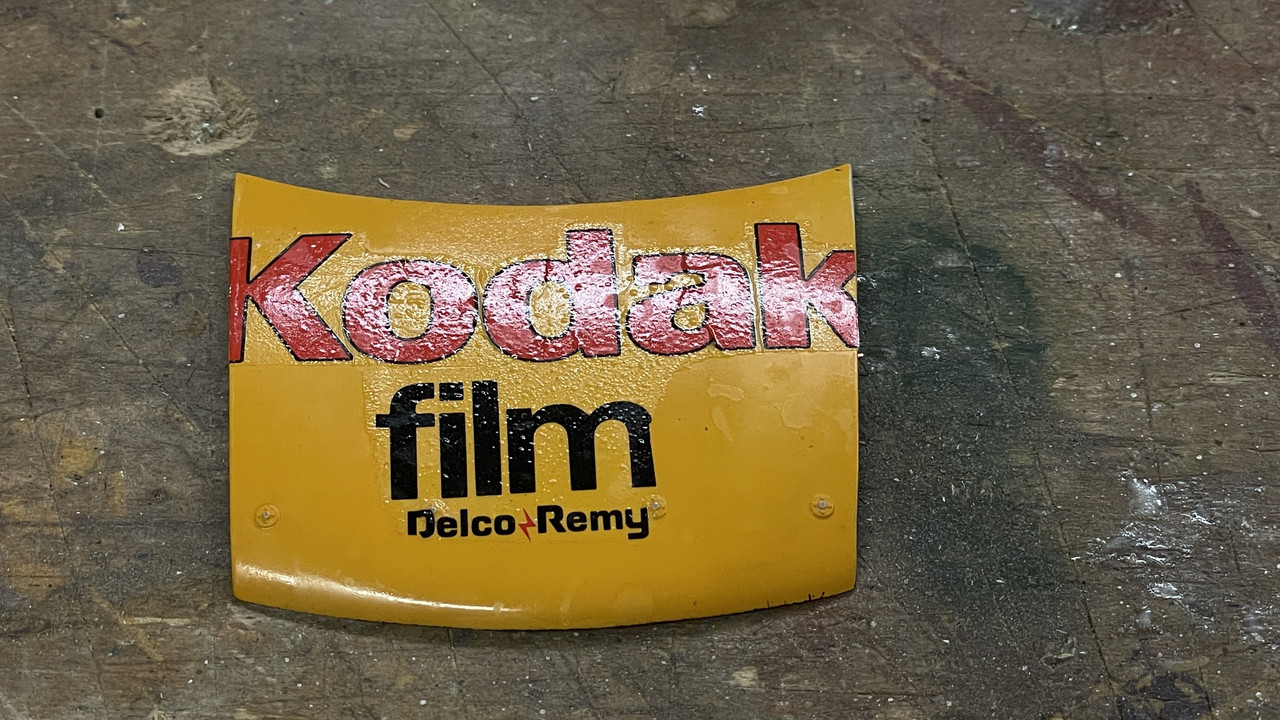
I looked into the possibility of substituting rear springs for the plastic ones, but that ship has left the dock. I did have springs of the correct diameter in a collection of springs I bought a few years ago from Amazon, but should have thought of this earlier. In another forum a reader wondered why I hadn’t changed out the springs. I hadn’t even thought of it.
To try and forestall further decal disintegration, I coated the sheet with some MicroSol Decal Coating Liquid. While this was curing I started working on the wheels. They have a terrible mold line right done the center of the tire. I cut off what I could with a #11 and then used my MicroMark power hand sander and other abrasives to make the tires look more like tires.

I also attempted to paint the “Goodyear” logo on tires since the car’s photos clearly showed white lettering. It’s passable, but not great.
I also got the radiator installed with the hose painted with Molotow decanted chrome. If you repeatedly depress the nib end of the Molotow pen, eventually a big blob will leak out and you can use it with a brush. It can also complete destroy a model if that blob comes out when you’re using it as a pen. I know this because, Brian Bunger, the owner of Scale Reproductions, Inc. (one of the best hobby shops in the USA) did this on a beautiful 58’ Chevy Impala model when painting the trim.
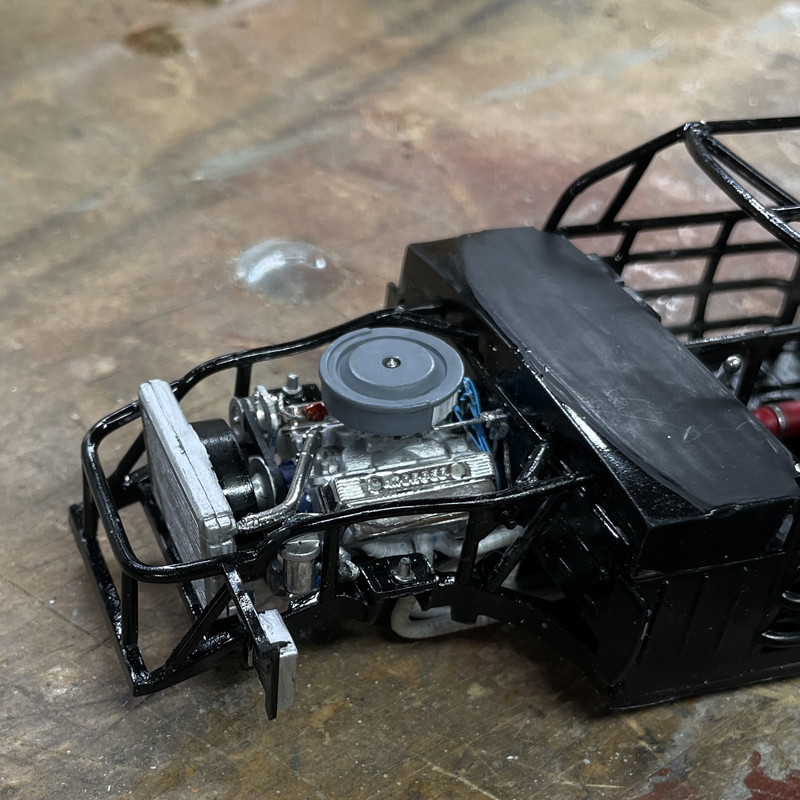
And then while attempts to assemble one of the wheels with the inner and outer halves, I dropped an inner rear wheel and its disc brake. The disc brake was sitting on the floor directly below my feet, but the wheel was no where! I mean NOWHERE!!! I crawled around on the cellar floor, expanded the search area, explored places where “It couldn’t possibly had gone”, and found nothing. I know round things can roll, but come on man, it should still be in the room… right?
I searched for a good 10 minutes. The part is no longer in this dimension. That’s the only possibl e explanation. In fact, I actually didn’t hear it land. Small parts can reach relativistic velocities and they’re falling and transit to the other dimension before hitting the floor. Go ahead. Prove me wrong!
So… in desparatiion, and always having a way out most jams, I’m in the process of turning a new one out of aluminum. Luckily, the inner wheel is just a plain cylindrical shape, unlike the outer half with the spokes, compound curves, lugnuts, etc.
This is like the one that diappeared.

And here’s the stock being prepared in my miniature, 40 year-old Taig Lathe. The lathe is a godsend and has gotten me out of a lot of jams, too many to count. It’s capacity isn’t much, but within that envelope it can work wonders.
I chucked the aluminum in a 4-jaw independent chuck because the stock had a large overhang (I hacksawed off the excess) and I needed a very secure clamping. The Taig 3-jaw self-centering chuck has aluminum jaws and can’t really tighten as much as I needed here. I used a dial indicator to true up the mount before turning. I can usually work within a couple of thousandths precision with the machine.
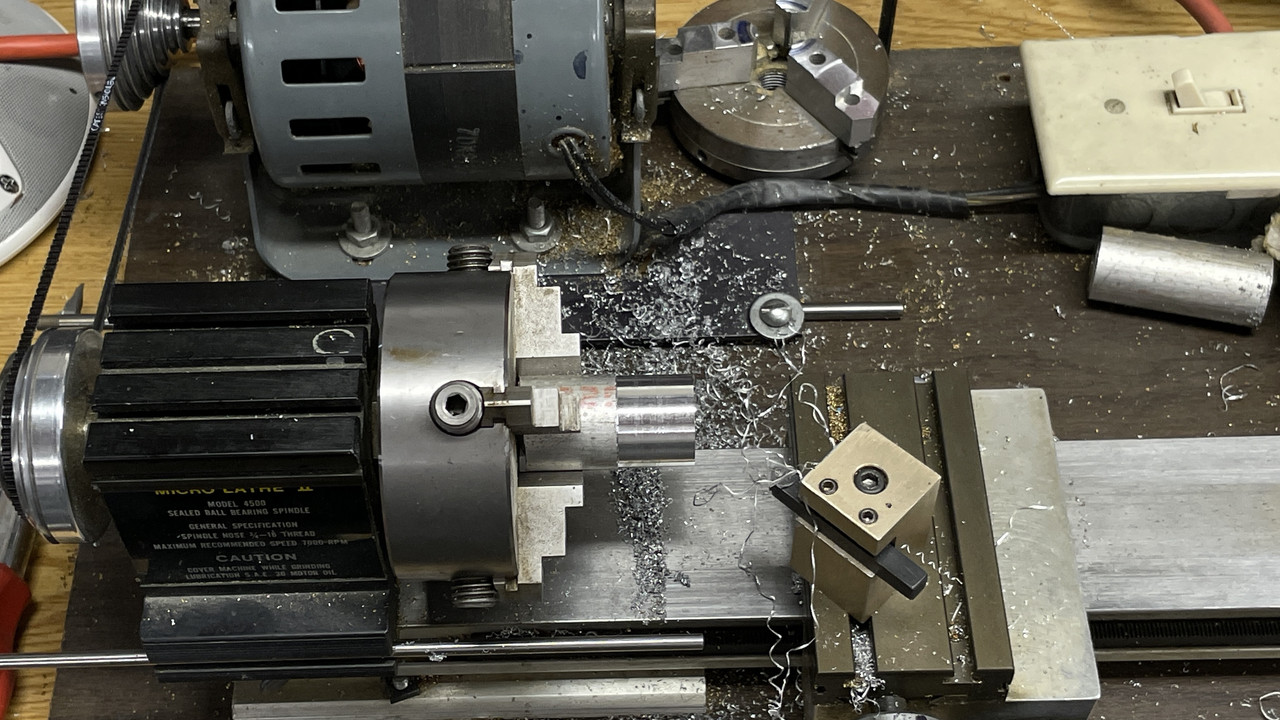
I may have more time in the shop today and I will post the rest of this small machining project.
Do you wear cuffed pants?
Looking good.
I love the wiring and hoses on the engine. I was bothered by the way out of scale thickness of the cooling fan, and would have suggested an alternative. But now I see the shroud completely hides it from view. You knew what you were doing all along.
Egads!! Sorry to see that you’re having such a rough time with the kit decals. From what you said, the kit was molded in the -80’s which makes it 40+ years old, but the real issue that the decals are the same vintage. Unless sealed and kept in a relative humidity level and temps for all those years, they would most likely start to deteriorate by drying out, which is what the cracking is caused by when soaked in water. The last picture with the Kodak hood decal looks like an over soaking in Micro Sol or Set and still hasn’t fully dried. Some of the blotches do look like there’s trapped water or air under the decal film. Rarely do I use any decal solutions and not carefully roll the decal as it’s in the final stages of having the solution dry.
Now that the decal is completely dry, what does the film look like now?
One thing I generally do is use After Market decals when the kit has questionable ones including being overly thick.
As for tires, the center molding line is a problem on just about on every tire from most kit manufactures. Just good old sanding and then a final sanding with a finer grit will do the trick, but don’t sand the side walls.
Nice job installing the radiator and hose.
For a non-car guy, you’re doing one heck of a job.
joel
Here’s what it looks like. Just took this a few minutes ago. Not as bad as I thought it would be.
When overcoated with gloss it should be okay viewed from 15’. Annoying this is. Could have made my own… May still do that. I have the power…
Also noticed on the prototype images, that decal sits a little higher on the hood exposing the hood locks below the “Delco Remy” logo. But, the decal is split so the rest of the “Ks” on both sides are separate decals and that’s where it needed to settle to have the graphic end at the hood lines on both sides.
Thanks, I did do that on the tires. They look pretty good.
Hope everyone had a nice 4th. Ours was subdued since the grandsons are not around much any longer. The older one, is working in Chicago at Medline as a systems engineer and the younger was spent the weekend at French Lick, IN, with old HS friends. We knew that this would happen as the kids grew up and we’re really happy that we moved here when they were little guys. It went very, very fast.
I got down to business on machining that “missing” wheel. It took three tries. The first approach, to do all the o.d. work, reverse the piece in a 3-jaw chuck and then treapan (cutting straight into the end of a revolving workpiece), didn’t work. The machine is chattering a lot and the wall thickness of the diameter was very narrow and it failed during the operation.
This was after the facing operation and before I attempt to trepan the bore. You can see the small lip that’s preventing the piece from sliding backwards in the chuck.

My second attempt didn’t even get started.
The third attempt, I reversed the workflow, doing all the boring ops first, then turning the o.d. and finally cutting off to length. This worked. It provided enough stock to absord the cutting forces. Trepanning is a tough operation since you’re plunge cutting which is a big load on the tool. It chattered like crazy, but this was an internal surface that won’t be seen. I also drilled the 1/16" hole for the axle.
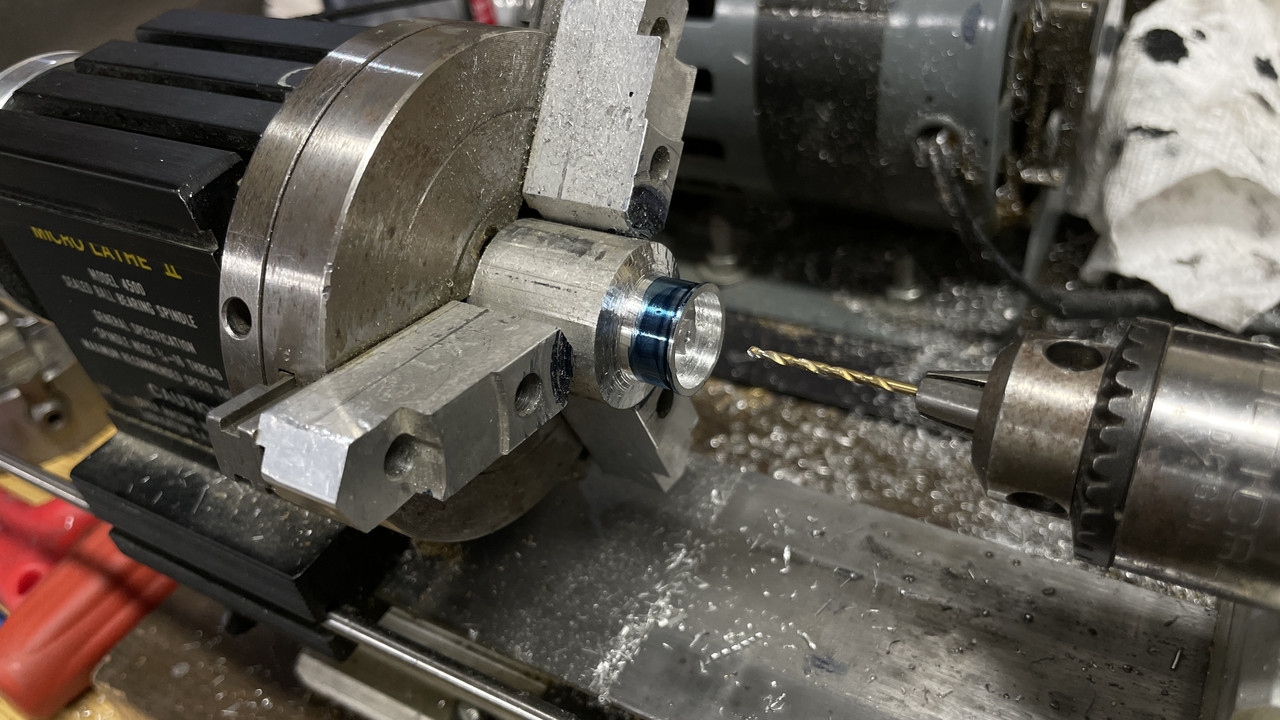
I had to regrind my little boring bars to enable them to clear the i.d.o of the drum and the o.d of the center hub. You can’t just own a lathe. You need a bench grinder too. My grinder is a Dayton machine that I bought in 1972 when I was teaching shop and fixing lawnmowers out of my garage. Good tools last a long time.
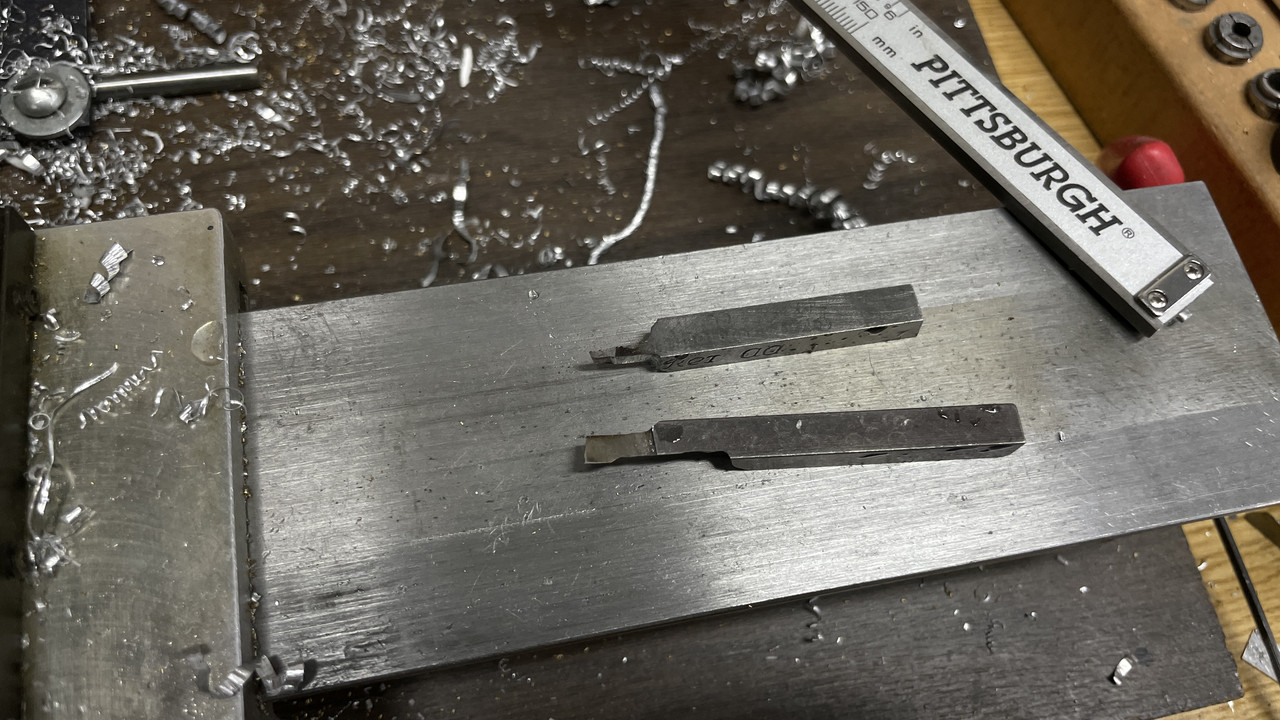
The new wheel fits the tire perfectly! And then, I found the missing wheel! I knew that was going to happen. It was in the darn tire!!! When I dropped the disc brake, I assumed that the wheel dropped too. I checked everywhere, except inside the tire itself. Reason: the tires had a black rubber center that needed to be cut out. When viewing the tire from the open end, they were black on the bottom. When viewing this tire with the wheel still inside, it too was black in the bottom. Ergo, I missed it. So I spend almost 3 hours creating an unneeded workable part. It was a fun machining practice.
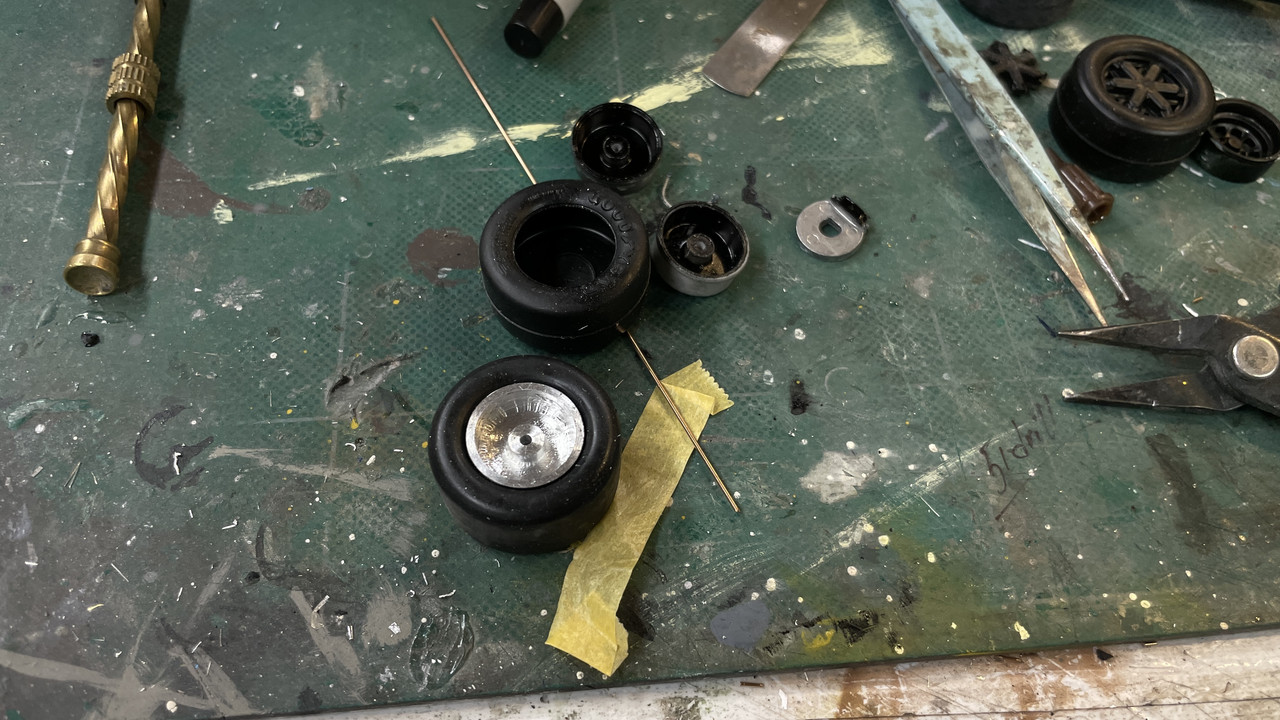
Up next, more decal fun and building up the front suspension.
I’m right there with you on finding missing pieces right after I replace them, usually with a 2nd kit. Impressive mill work on that wheel.
Nice save on the hood decal.
We’re both in our 70’s and still live on LI NY. Our son lives in Rochester so it’s a good 8 hours drive one way. My brother does live close but just about everyone else in our families either passed on, or moved out of state. A few unfortunately did both.
joel
I painted myself into a corner by assembling the full rear end without the driveshaft installed. In my attempt to get it in, I popped loose most of the glue joints including the ones holding the rear coil springs in place. This presented an opportunity. I’m going to make “real” springs. The quotes are because, while the springs themselves will be real, the mountings will not permit them to flex, nor does any of the other suspension components have the abilty to move. It will just look much better.
And Tank_1812 suggested it. I always take readers’ suggestions whenever I can. I wasn’t going to rip the thing apart to replace the springs, but since it kind of fell apart on its own…

I also got all the tires and wheels assembled and the tires painted. After a bunch of fussing the tire paint is okay. Not great… just okay.
I’m going to turn the spring mounts out of brass and have visualized how I was going to go about it. The springs have to be compressed to the correct size and held that way without putting any pressure on the fragile plastic parts. To do this I will machine the main body with the mounting pins on each end and one flange that holds one end of the spring. I’ll then machine a round plate with a hole in it that will compress the spring. I will solder this in place at the correct distance. That’s the biggest challenge… holding it compressed while I do the soldering. I’ll figure it out. I’ll use the resistance soldering unit that will help me clamp and solder at the same time. Stay tuned…
BWT: What kind of hood hinges do NASCAR cars have?
Making lemonade out of lemons. ![]()
![]()
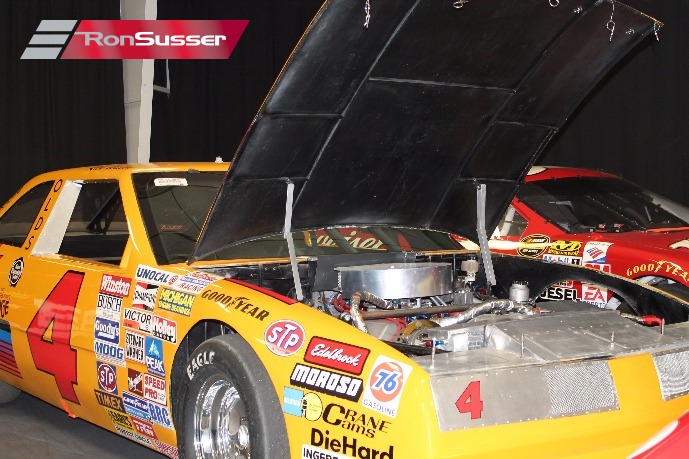
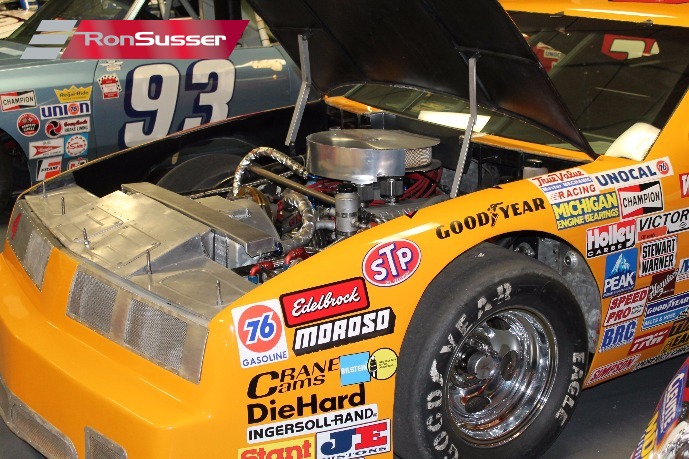
I don’t really think those things actually can work as hinges. It almost looks like they were cobbled together to hold the hood for the display. They look mechanically ridiculous. And WOW, the’s the Kodak Olds. The spark plug wires are red and the air cleaner looks like a homemade one in a high school metal shop. I know that because I taught HS Metal Shop from 1970 to 1975. The upper control arms are bare metal so that’s more information that deviates from the kit’s instructions. Thank You for finding this!
And these springs are dedicated to you!
Really got into the spring making today. Instead of machining the 1/16" pins on both ends of the spring assembly, I decided to use a piece of 1/16" rod soldered into the spindle. Now, I realize that the scale springs DO NOT have a central column, but are supported by both ends fastened into the car’s frame and rear axle. I didn’t want a working spring since the force would rip apart the fragile construction. I machined a spindle with one end having the larger retaining flange (as per the plastic version). Then drilled it slightly oversized than 1/16" (#51 drill) since I was going to solder it in and didn’t need a tight fit.
This image shows the spindle after soldering with the Resistance Soldering Unit (RSU). I machined a small lip on the flange to help center the spring.
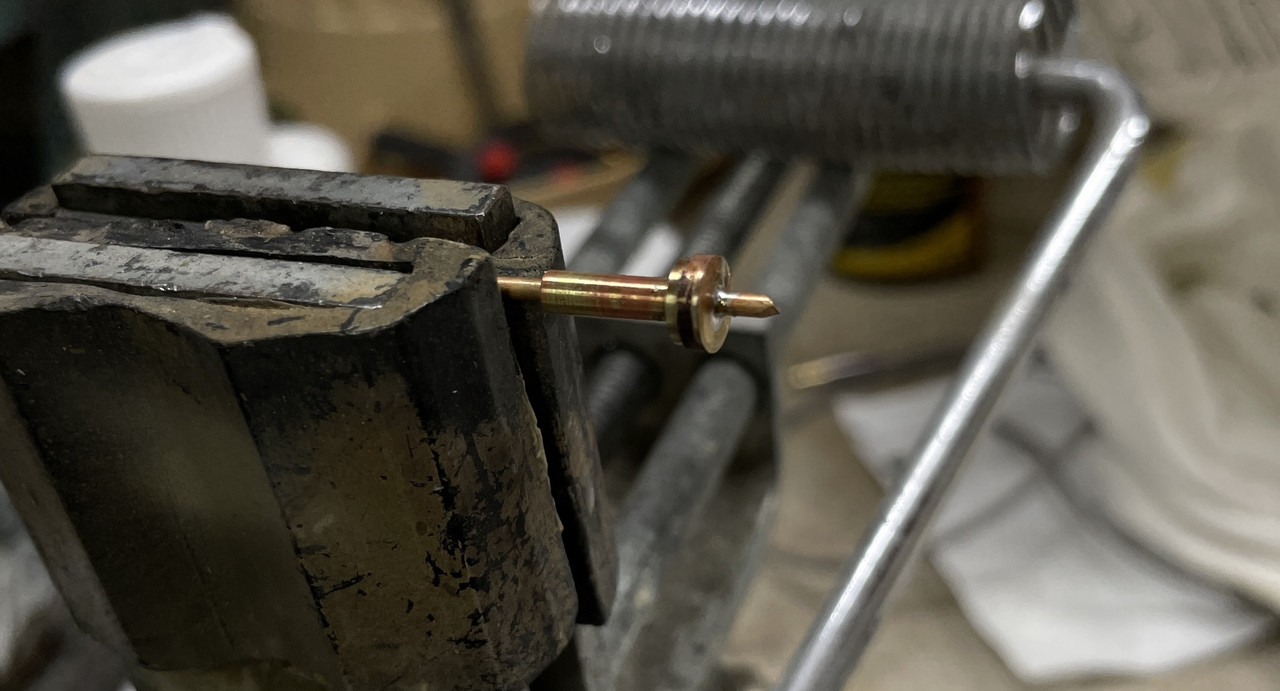
To retain the spring I first tried it with a phos-bronze retaining pin in a cross-drilled hole. I filed a small flat on the spindle and then drilled with a 0.033" carbide drill. It was very careful, slow going work. When the drill grabbed just as it was exiting, which often happens when drilling brass, it broke. I was able to extract the broken drill and the hole worked.
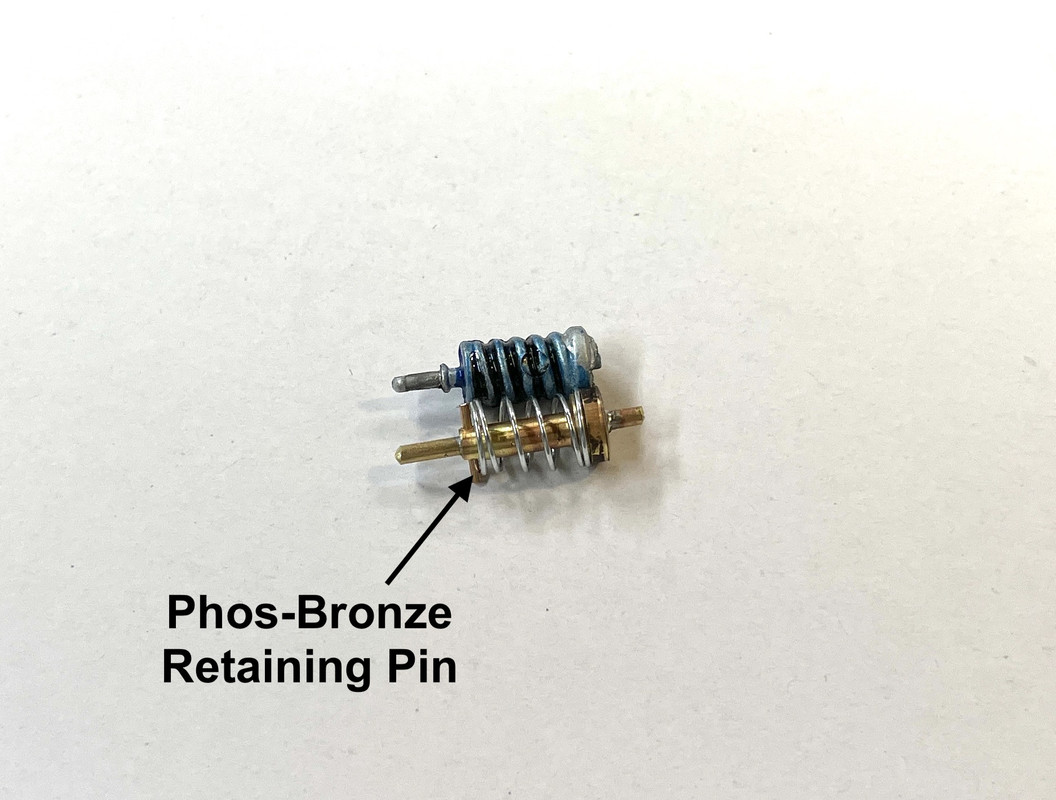
For the carbide drilling reason AND the tendency for the spring to work itself around the pin, I decided to go with Plan B. Plan B was to make small retaining plates drilled for the spindle diameter and again using the cross-drilled, but this seemed like overkill. I then went with Plan C using the end plate and then soldered in place, again with the RSU. As I noted in yesterday’s post the RSU has the ability to hold something while soldering and I used that feature to full advantage here.
I compressed the spring while maintaining electrical contact with both the plate and spindle. Solder ALWAYS flows to the heat. By heating both surfaces with the current flow, the solder joined both pieces quickly and with strength. The power is applied by a foot pedal. You heat and solder, but don’t let go of the tweezers until the joint cools and is stable.
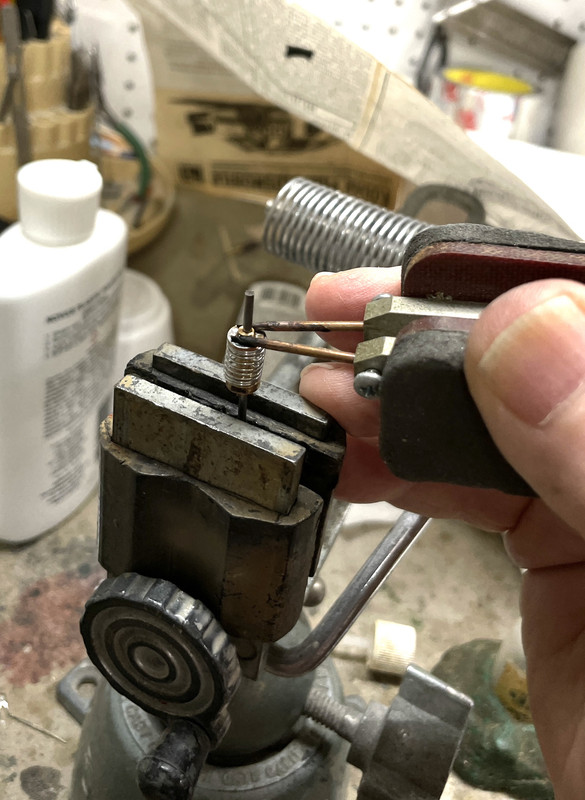
Here are the two rear springs completed compared to the kit’s plastic part.
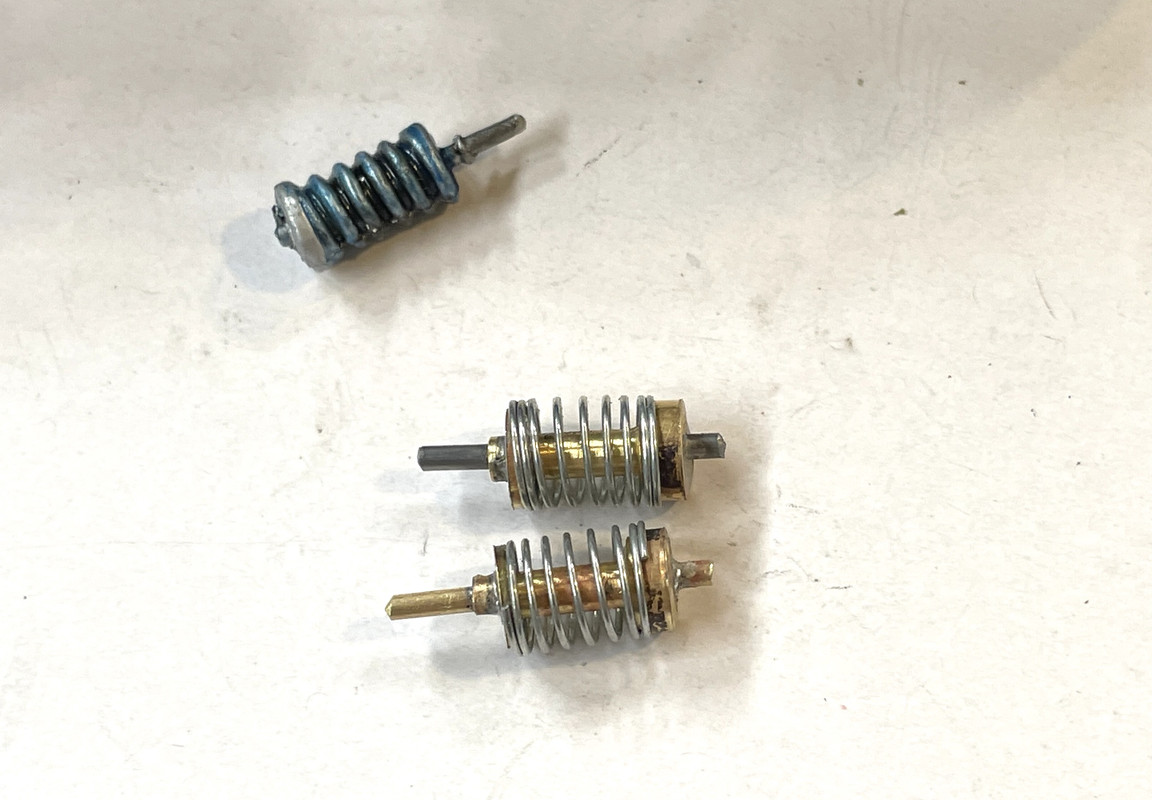
Their diameter is slightly wider than the plastic version, but that’s okay since these were the springs I had. I could have wound my own, but that would be making this an even more intense project. When installed, as you’ll see, the effect is fine.
I chemically treated the finished parts with Jax Brass Darkening Solution. It’s pretty dark. I can still paint them if that’s necessary. I’ll leave it up to you guys… paint or not paint?
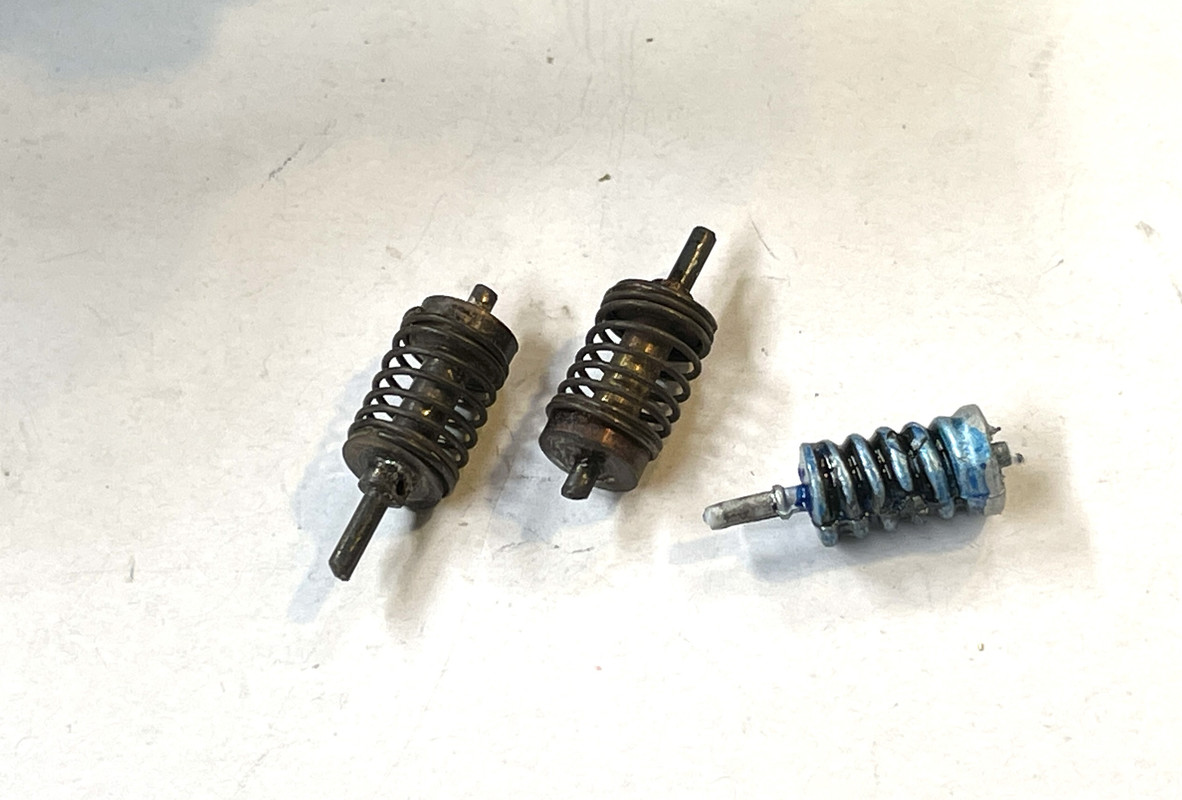
I had to open the holes in the model to accept the slightly larger diameter mounting posts. I installed them for this image, but did not glue them in (CA of course gluing metal to plastic). I like the look.
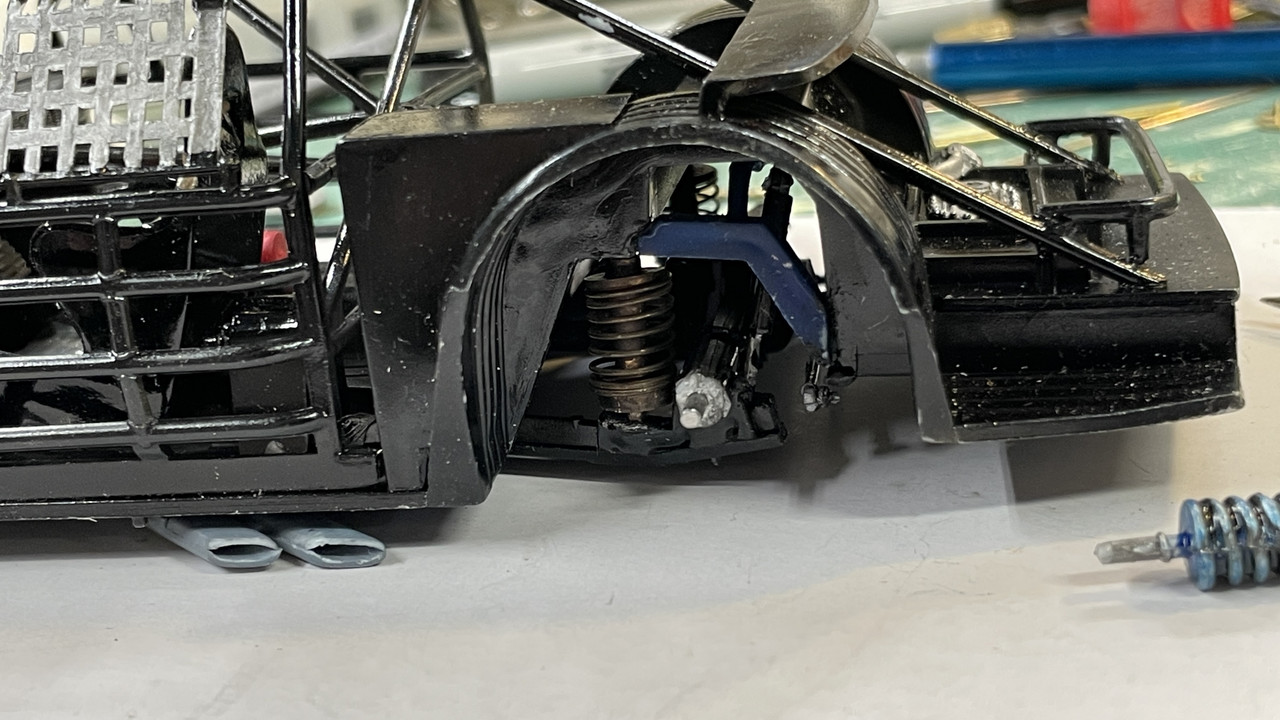
With the central column they look like a strut with the spring wrapped around the shock absorber. Speaking of shocks. I have to scratch build one of those to since one of them got whacked when I was attempting to get the drive shaft in.
Next up will be the front springs. Now that I have the machining and assemnbly routine figured out, making them should go quickly. The front springs are a smaller diameter than the rears, and I have springs of a smaller diameter will work.
They might not be but I don’t think they were that enforced then.
Found this one.
I found this one years later on a Chevy car.
Those springs look great and really change the look. Granted it’s mostly covered by the wheel. For display maybe have a jack under one side to show it off? Just thinking out load.
Keep thinking. I will try and fabricate some kind of hood hinging scheme. I also had to go through the trash to find the chrome parts for the jack. I was threw it out since I wasn’t planning on using it. If I do use it, I will have to machine a decent looking brake disc since the plastic ones are disgusting. Now I have to decide front wheel or rear to remove?
Machined and built the front springs. They are shorter and narrower than the rears. I used a smaller spring diameter and had to cut the length in half with a hard-wire cutter. Again I changed the scheme. Instead of machining the inner sleeve, I just machined the ends and used the steel shaft to both establish the length and serve as the mounting lugs. I drilled the stock first, then turned the .117" centering land and then the .160" o.d. I moved the cutoff tool over and cutoff the piece. After the first two, I added a twist (no pun intended) by letting the drill remain in the cut so when the work piece parted from the stock, it didn’t go into the ether. This worked elegantly.
I cut the land almost by eye so the spring just slid over it without much play.
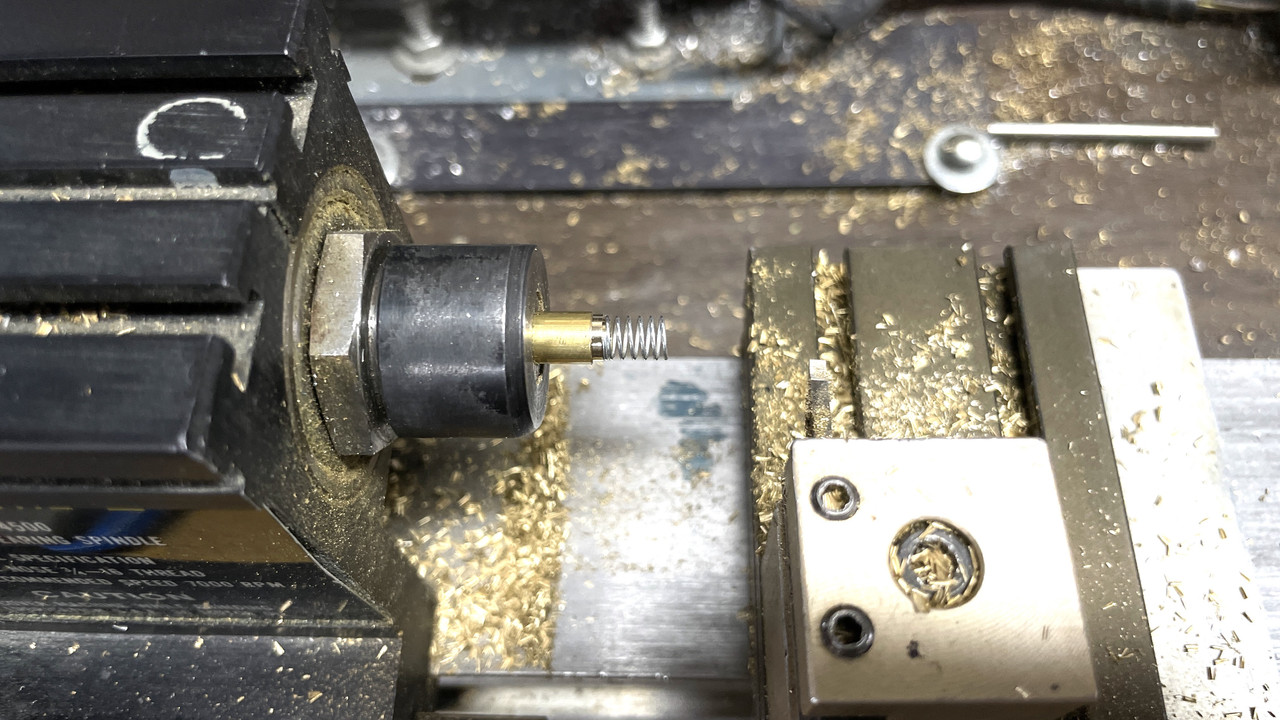
Here is the cutoff operation with the drill supporting cutoff workpiece keeping it under control.

I soldered on end onto the steel center rod, placed the spring and then soldered on the other end. I held the center rod in my PanaVise, and applied enough pressure with the RSU tweezers to set the spring compressed length. While holding it at this point, I soldered on the other end plate. This worked nicely and was simpler than yesterday’s method on the rear springs.
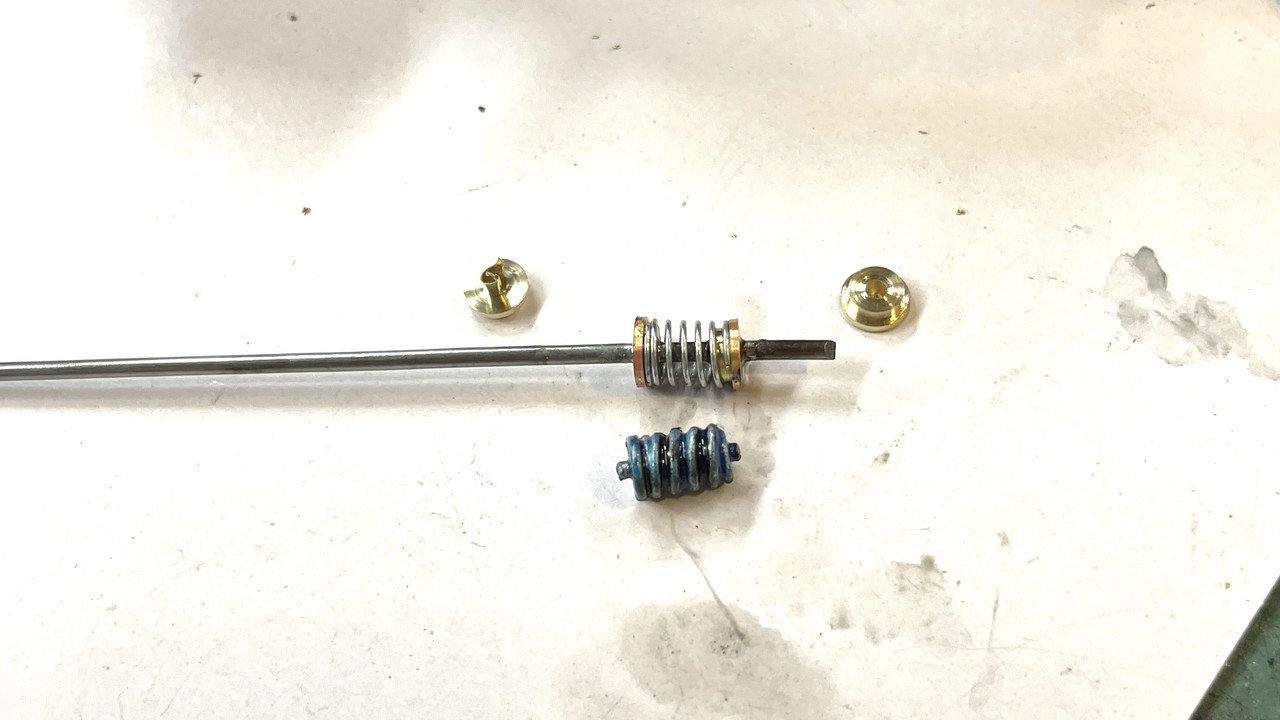
Afer soldering I clipped off the excess center rod with some beefier flush cutters.
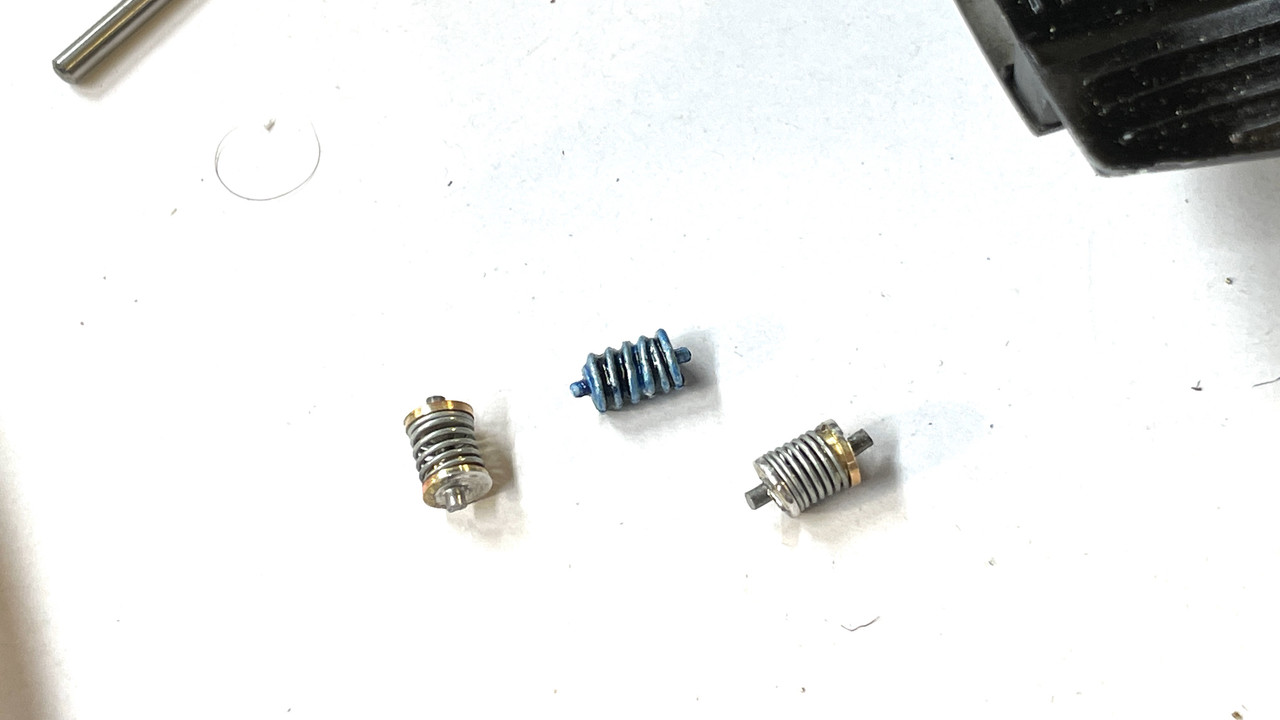
They compare reasonablly well to the kit parts. My springs have more turns, but I don’t care. Chemically treated these like I did the rears.
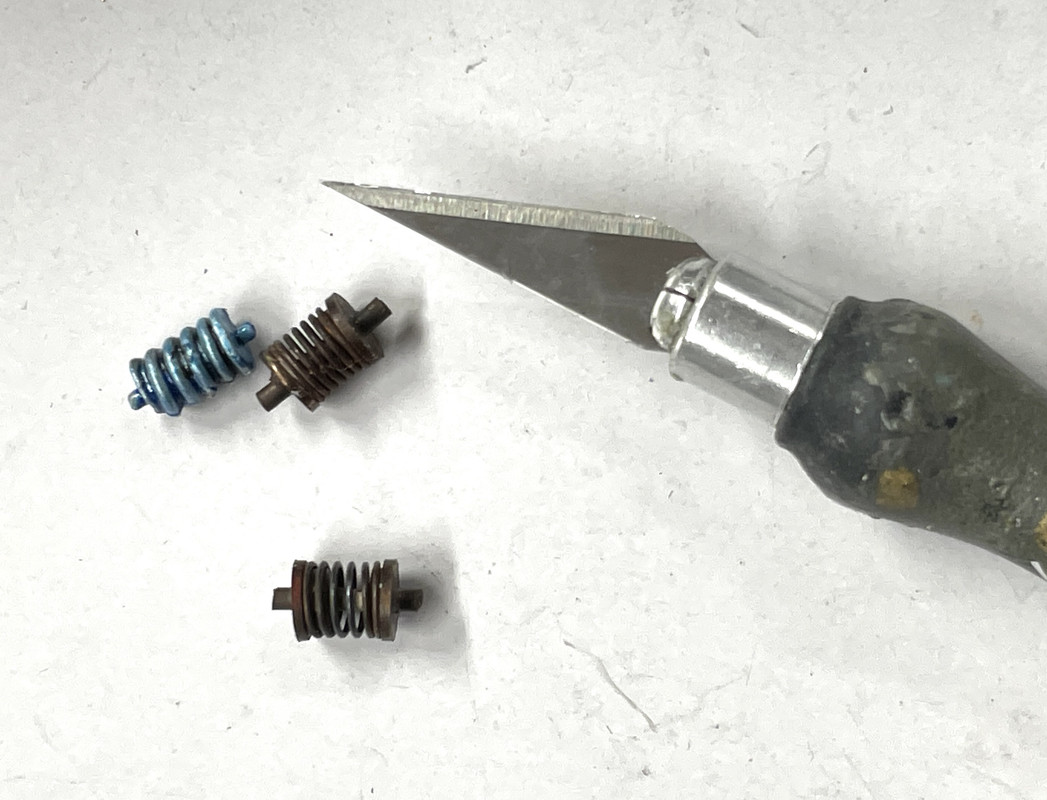
With the machining jobs done I turned my attention to remaking that broken shock. This little job took more time than the front springs. It wasn’t hard conceptually. It was hard because I kept breaking solder joints or losing tiny parts and had to make stuff over.
The scheme was cut a piece of brass tubing on the power mini-miter saw as the end lug and solder that to a piece of properly sized brass rod (3/64"). Easy peasy. My first attempt was using a larger tube for the lug because I couldn’t find the one piece of 1/16" brass tubing that was floating around the work bench. I drilled out the plastic shock cylinder for this rod and measured the exposed length of the piston rod on the unbroken shock. My first attempt had the rod very long and was going to cut to length after soldering.
My next attempt had the rod the correct length. This actually was easier to solder holding the rod with the RSU tweezers and pressing it lightly against the lug that was held with a T-pin.
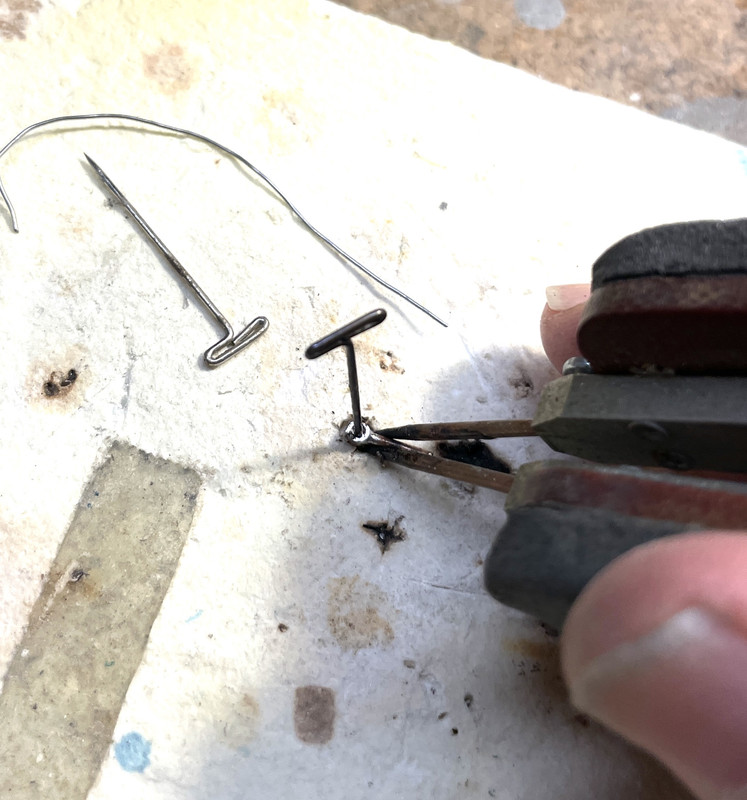
I attempted to install this repaired piece in the car, but the lug was too deep. I took it to the belt sander to “lightly” reduce the thickness. This didn’t work! It broke the piece apart and through the lug end into the ether.
My next attemp had me soldering the cross-pin into the lug, and using this “tail” to stick it into my soldering pad. That stablized the lug end, and then soldering the piston rod as before. This worked!
This is the completed shock not yet painted.
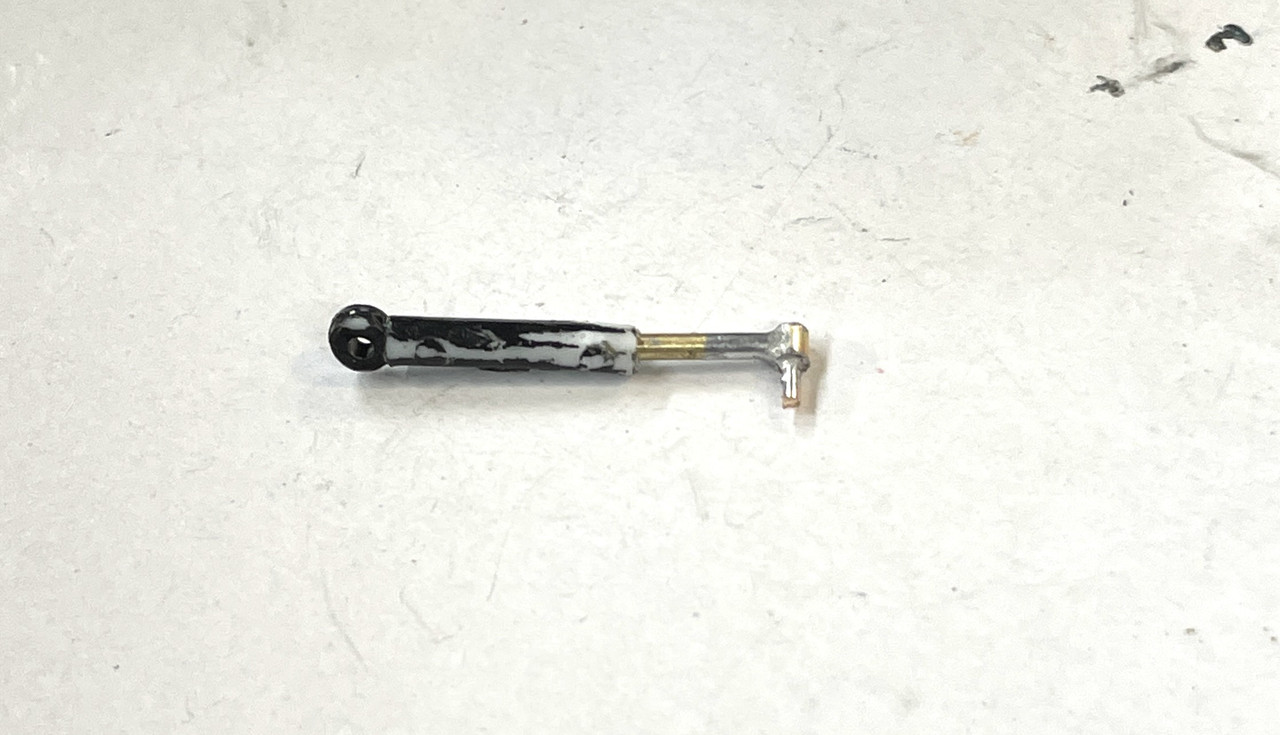
And the shock installed. This wasn’t easy either since the shock mount also had been partially broken in all the tummult. Medium CA with accelerator is holding it together. After repainting I’m hoping that the true poor condition of this joint with not be too evident.
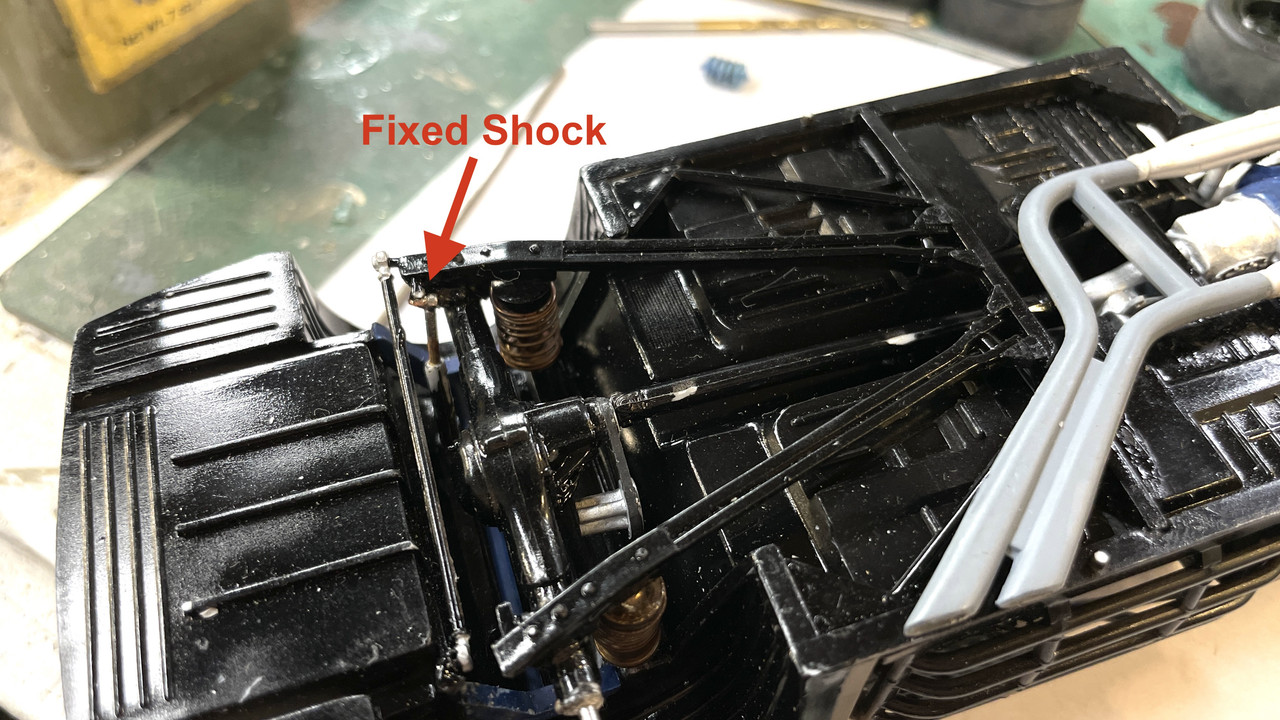
Everybody have a safe and fun weekend. See y’all on Monday.
Stainless steel shimstock and the appropriately sized punch? You could really have fun with that and put two together with little spacers along the edge to make it look like a real ventilated disc.
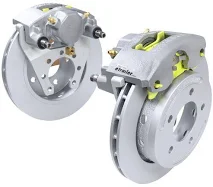
Love the work. It really changes the look. ![]()
![]()
Instead of a jack, place on a clear wedge shape base representing the angled track. Reading a review that said the model is step up for short tracks, Bristol is angled 24d-28d in the turns. That might do it.
Thank you! I give that some thought. I have a lot of clear plexiglass laying around that I could put into action.
More modeling today and more wrestling with those &%#)&@) decals.
I didn’t like he kit’s disc brakes at all. I decided to draw some new ones and 3D print them. I suspected that someone in the SketchUp World already drew some, but when I searched on their 3D Warehouse in a category that I suspected I’d find one, I only found one and it wasn’t sufficient, so I found a prototype on ebay and drew it myself. Then I had to draw a reasonable caliper. This time, I searched “no category” and got a page of disc brakes with calipers. I used one that I thought would work. It’s not a bona fide NASCAR brake.
And a bonus was the fellow who drew it did it so it could be printed (all solid, no reverese faces, etc.). I had to adjust the size to the kit’s brake diameter. It had a center hole, but I didn’t worry about that.
This drawing contains several things. The very large disc is my version before I found the nice drawings. It’s scaled 100 times larger than the 1/25 scale part I was making. You do this with SU. It doesn’t like to draw arcs that are too small. The trick is you draw the begining of the job in the scale you want and turn it into a component. Then you copy it and enlarge it as many times and you think you need to get it to draw properly (typically 10 or 100X). You then open the copy and do all your drawing on it. Being a component, every thing you do to the big one is also happening to the small one (like magic). When you’re done, you just delete the big one and the perfect 1/25 scale version is sitting there with all the detail. It’s a SU quirk (no a bug, just a feature). While it doesn’t like doing the original drawing in a small size, it has no problem duplicating all those small curves that are done on the enlarged version.
If you look carefully you can also see tiny 1/25th scale parts, and the beautiful downloaded ventilated disc assemblies.

I had first loaded my version (without calipers) on the ChiTuBox Slicer, and then added all the new ones. I modified the holes in one style to conform to the front spindle part of the model.
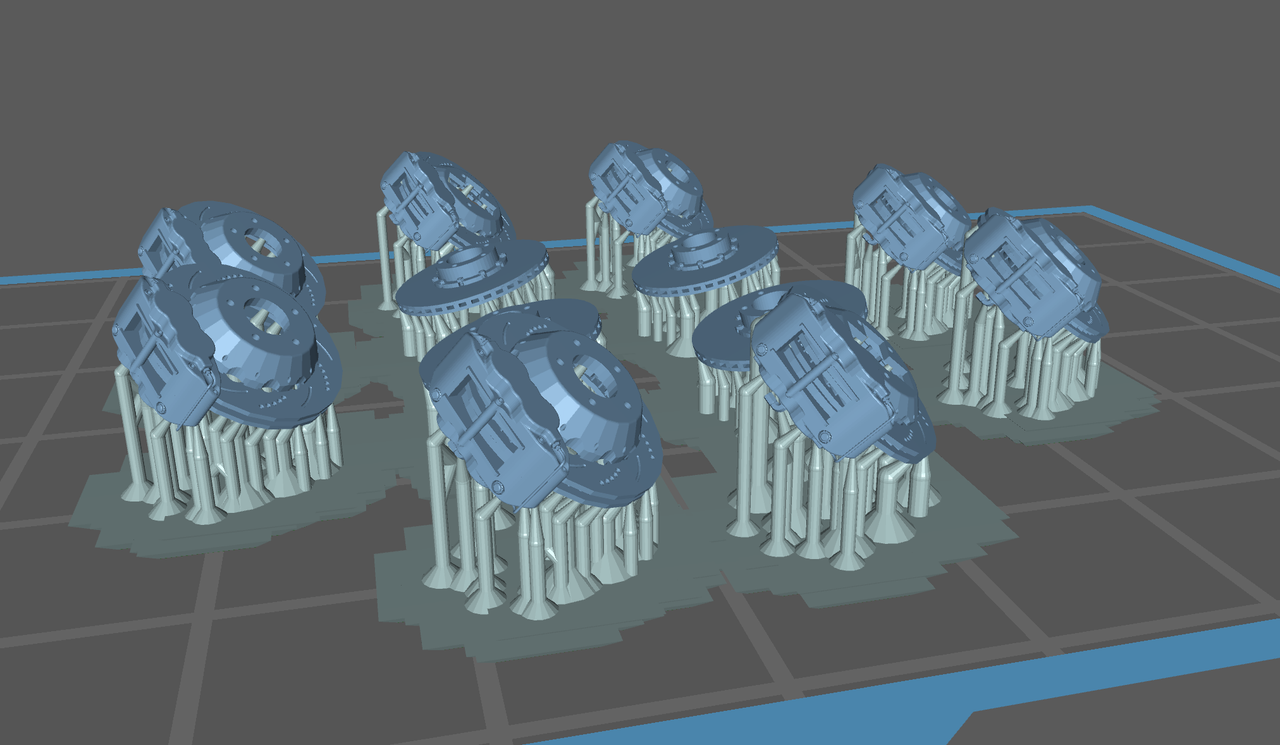
I put all of the supports on manually. The Slicer shows you where any overhangs or islands would form by highlighting them in bright red. The brighter the red the more severe the overhang. I used mostly light supports, but placed a few medium ones in strategic locations.
Here’s the output.
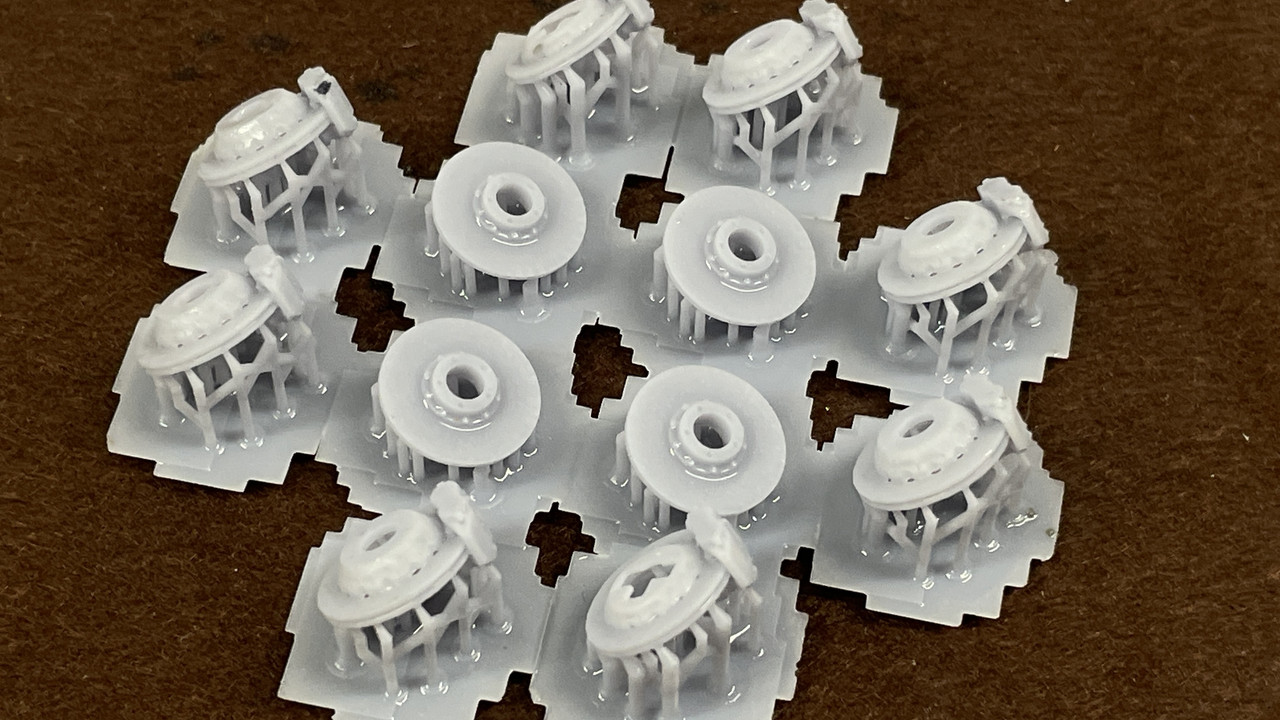
Prints were successful, but the cross-sections were a little thin in some critical locations mainly how the hub ties into the surrounding flanges.
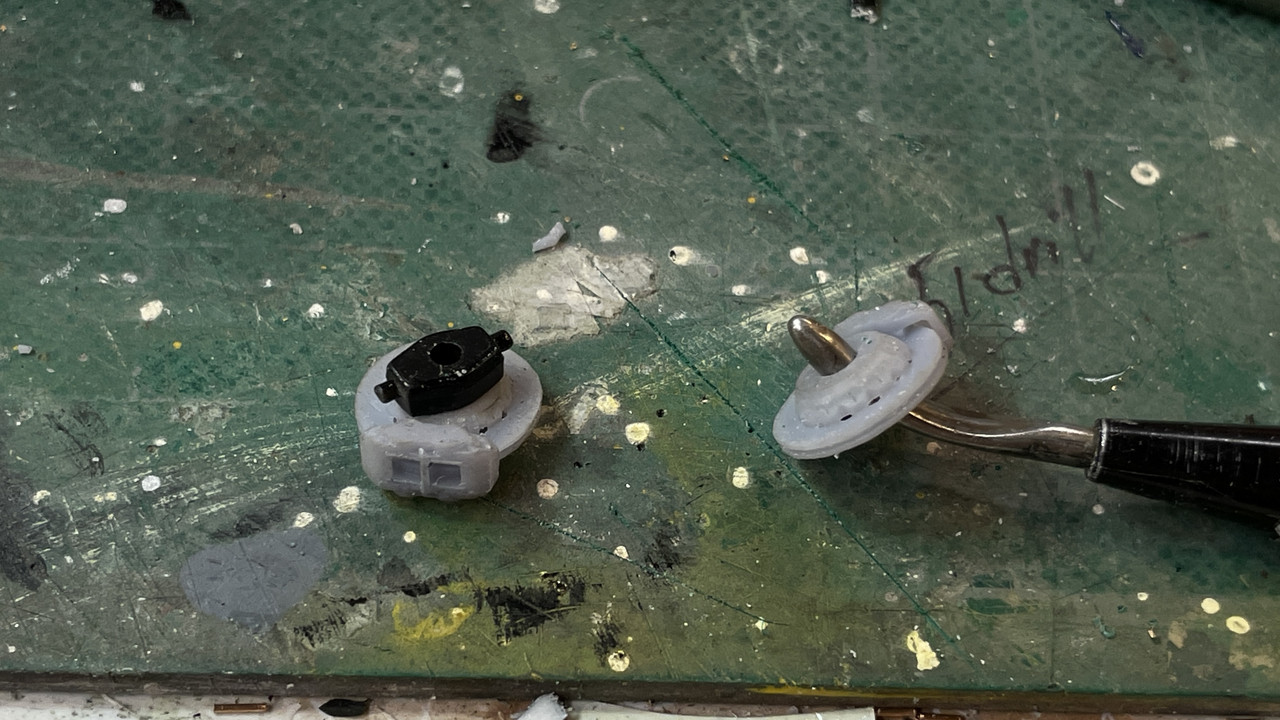 It’s nice that you can make out the ventilation ribs and cooling channels. After painting it will be interesting to see how well they look. After reinforcing the hub area with Bondic UV Curing Filler, I attached the kit’s steering knuckle. I also had to do some minor surgery on the spring pockets in the front end frame to accept my homemade springs. My springs were marginally fatter than the kit’s and needed some relieving to fit properly. Used the Dremel with Flexi-shaft and 1/16" carbide router.
It’s nice that you can make out the ventilation ribs and cooling channels. After painting it will be interesting to see how well they look. After reinforcing the hub area with Bondic UV Curing Filler, I attached the kit’s steering knuckle. I also had to do some minor surgery on the spring pockets in the front end frame to accept my homemade springs. My springs were marginally fatter than the kit’s and needed some relieving to fit properly. Used the Dremel with Flexi-shaft and 1/16" carbide router.
While this all was printing, being cleaned or post-cured (about 2 hours), I did all the rest of the decals. It was a pitched battle that lasted until the very last one, but I prevailed. Next time this happens, I am definitely going to make my own decals. These were a royal pain in the butt. And the car has LOT of decals.


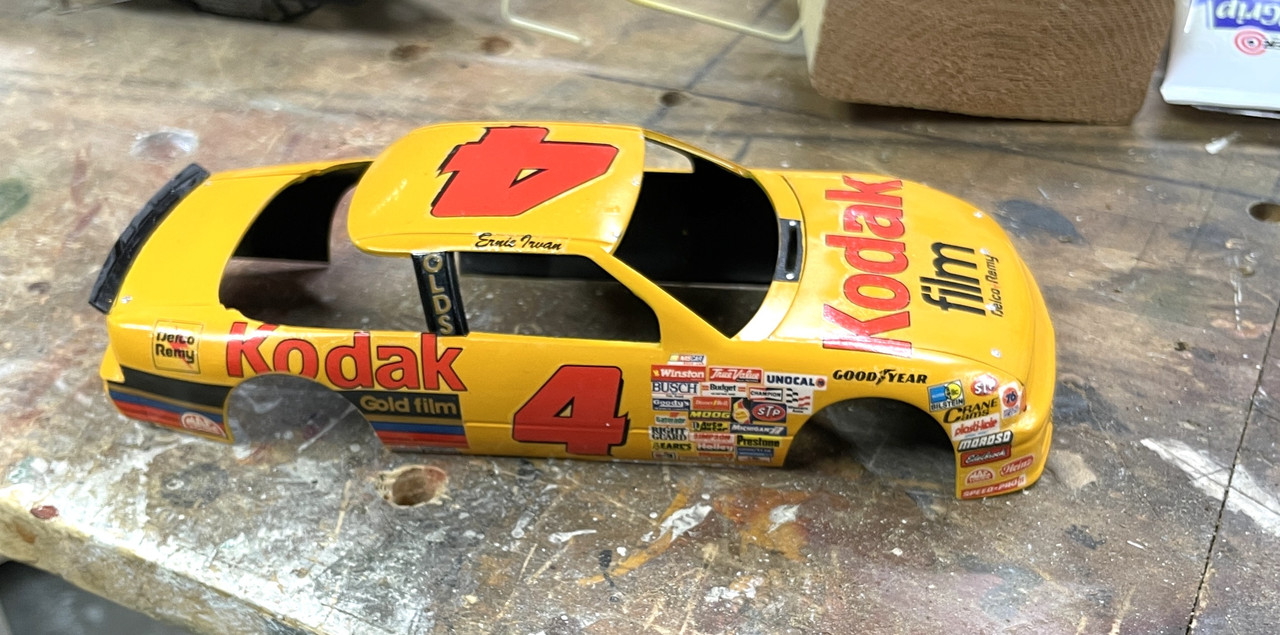
One of the “OLDS” decals broke apart in the “door” pillar (in quotes because NASCAR doesn’t believe in doors.), the “Kodak” decal on the right side, and chunks of several other decals all over. The MicroSol Decal Coating did work.
Next session I will finish up the front end and the chassis will effectivley be finished.
Until next time.
I needed to reprint both front and rear brakes. The rears didn’t really fit and the fronts didn’t either, and were weak. I revised the drawings to beef up the center hub and changed how the rear brakes go onto the rear axle housing.
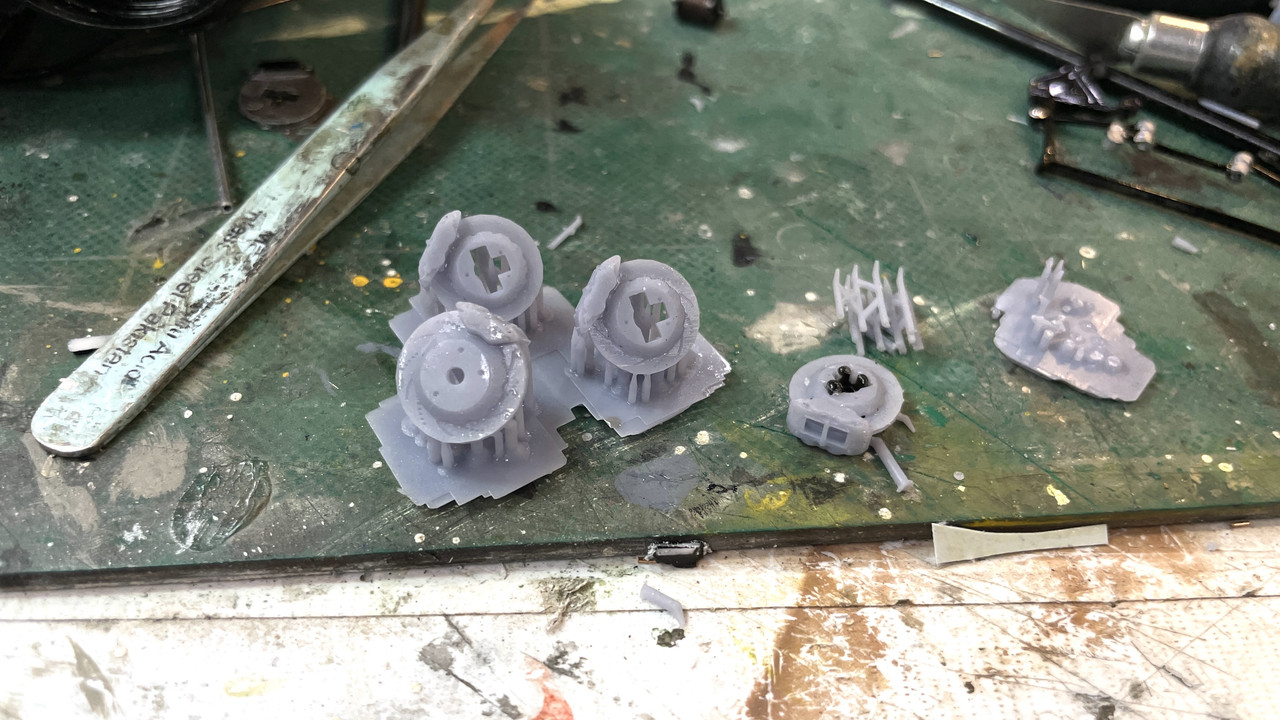
The rear brakes now slips nicely over the axle housing and the axle protrudes enough to hold the wheel.
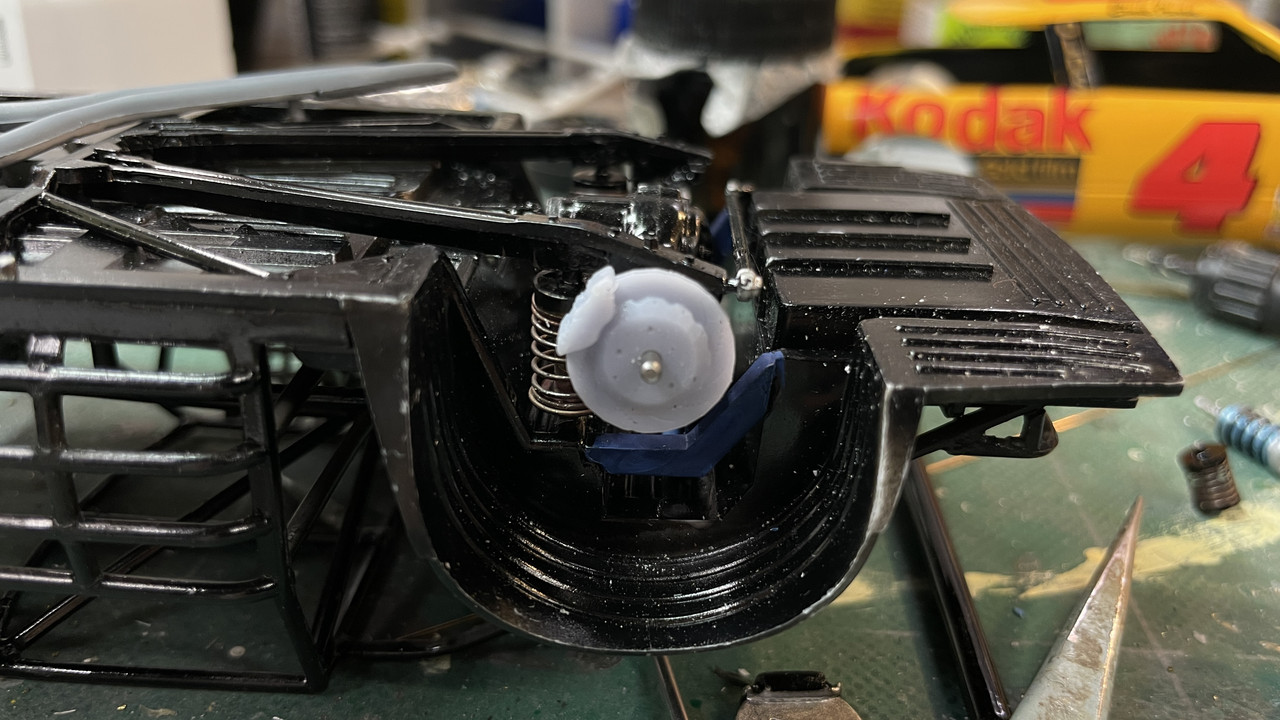
However, the front brake, while being more robust, has the caliper in the wrong location and it fouls insertion of the spindle into the A-arms. Since the caliper is integral to the disc in my print, I had to go back to SketchUp and rotate the caliper to the 3:00 position. It’s on the machine now. Print takes about 1 hour 10 minutes. I’m printing at 30 microns per layer since it’s such as tiny part. At this resolution, the tiny vent holes in the disc’s surface actually are holes. When the printer is working well it’s just marvelous.
Here’s version 2 and the interference.
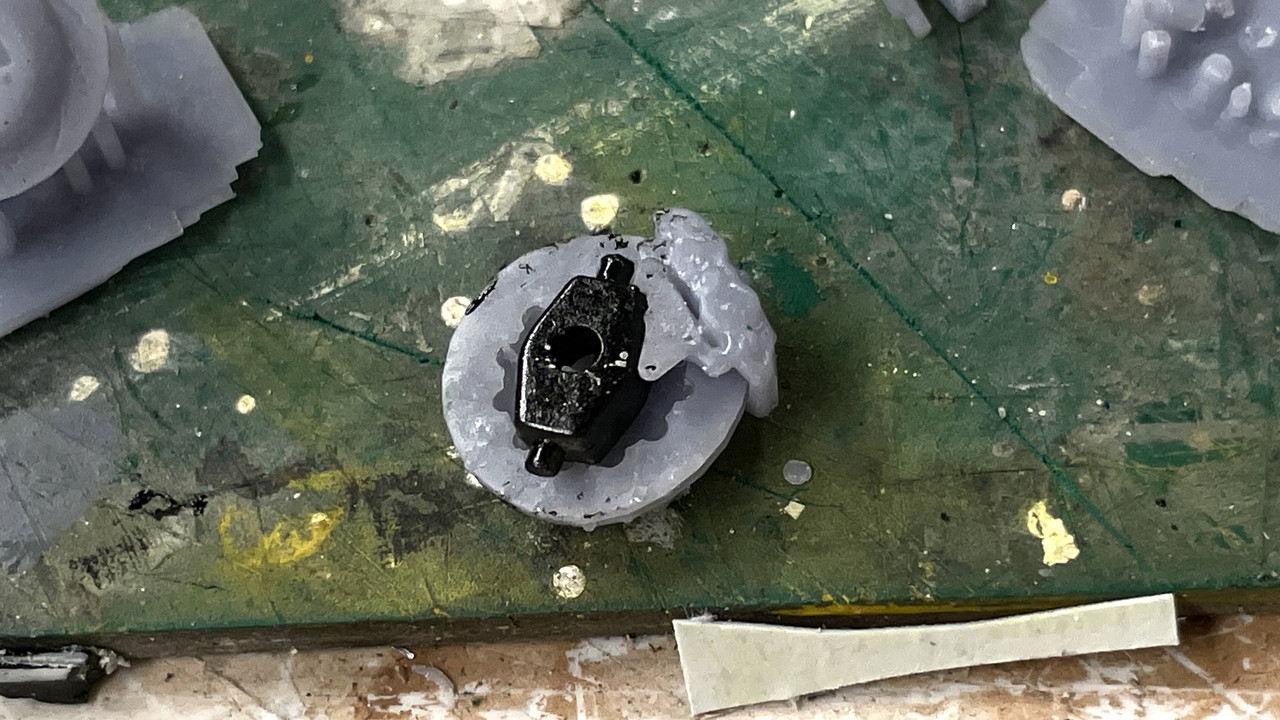
The beauty of building your own parts on your own printing system is the ability to do it over and over until you get it right. The downside of building your own parts is the ability to do it… you get the message. As usual, a blessing and a curse.
The new front discs are correct and really nice. I post-treated them (to finally harden the semi-hard UV resis), cleaned up the small amount of support debris and got them ready for the first coat of paint. I always remove supports before post-treat. After treating, the parts can be a little to brittle to take the shock of support removal and you can lose details.
My slight enlargement of the T-slot was just enough to let the steering knuckly fit wihout side pressure.

I painted the one side, let it dry enough to handle, flipped them and did the second size.
The paint was not fully dry in this image and is still hiding some of the nice surface detail. I’m letting them dry overnight before doing the next colors. I’m painting the hub part steel and the calipers bright red.

I’m trying a new chrome paint by Humbrel and it lives up to its reputation. It’s very bright and nearly as bright as the Molotow pen.

When I said that printing could resolve the cooling fins, I was not kidding. This is a detail that would be impossible by any other method including investment casting or resin molding. You couldn’t created mold that would have those internal details in a single part. They’re even curved as they would be on an actual disc.

While this was drying I continued working on the front end. Besides the left exhaust falling apart when I was trial fitting the steering gear and lower A-arm assembly, and forgetting to inserting the spindle into the front wheel rear half, everything worked well.
As with the rest of this old model, steering gear mounting, other than into the steering arm, was ambiguous. There was not much to clue you into just where on the frame it tied in. When trying to make room for the steering shaft, it popped the tenuous left manifold off and that took the collector too. I ended up pinning the collector to the frame with a 0.032" phos-bronze rod, and cleaned up the manifold mounting surface of old glue and put it back together with CA. This was at least the 3rd time that manifold came off.
I got the upper A-arms in place, trial fit the shocks and let it all dry until tomorrow to glue it all togther.
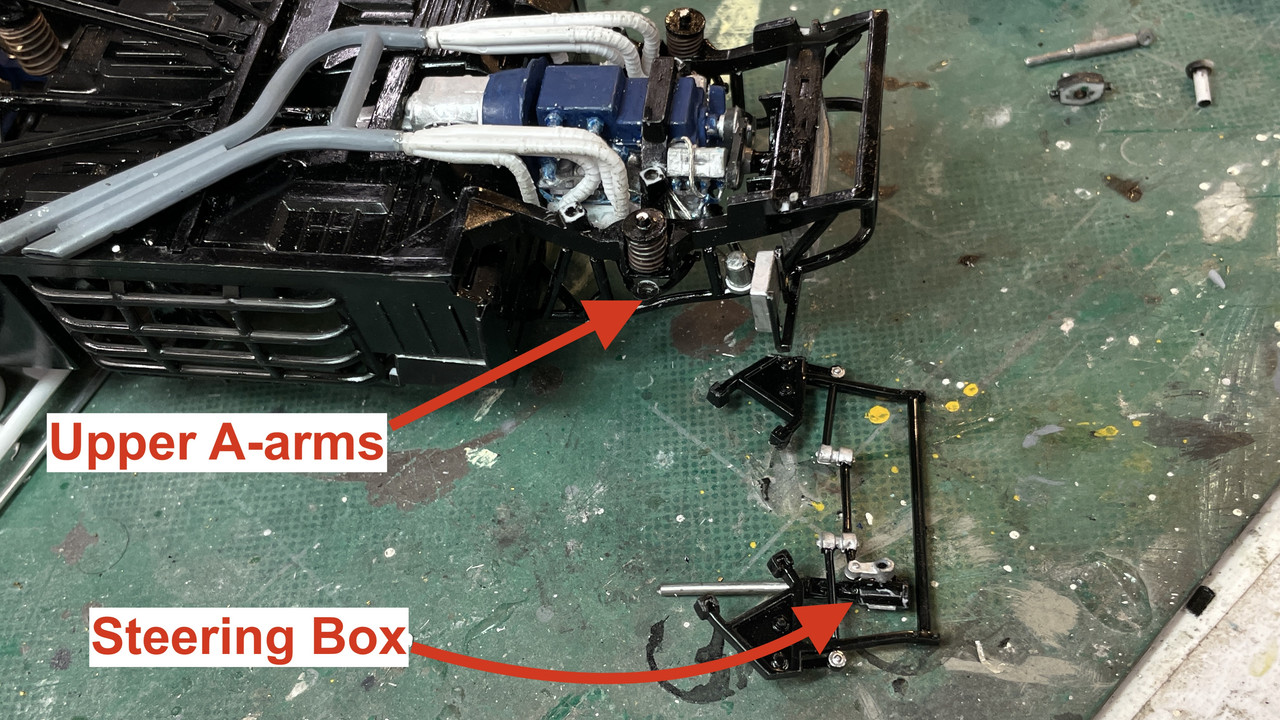
The plastic spindle was supposed to be captivated between the front and back wheel parts, but I glued them together before putting it in. I didn’t realize the miss until I was noodling how the wheels attach to the steering knuckle. For some unknown reason I was thinking the spindle went behind the knuckle and attached to the wheel. Instead, it protrudes out of the wheel itself. I tried in vain to break the glue joint between the wheel haves, but as Murphy would have it, the only glue joints that fall apart are the ones the MUST stay together. I cut some 5/64 steel rod to make some pins of the right length and then CA’d it into the wheels.
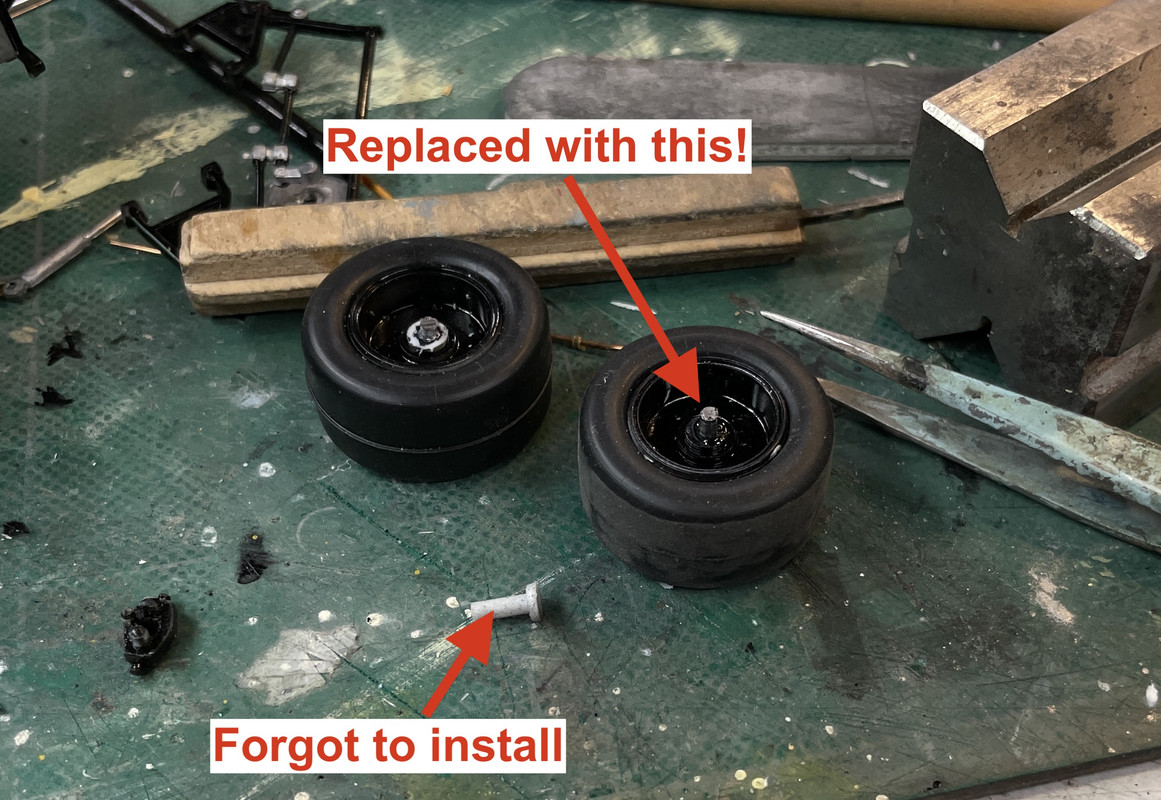
Because of this blooper, the front wheels will be permanently glued and unable to revolve. There’s no reason for rolling wheels on this model anyway. The parts are much too fragile to take any form of “play” activity.
With a tiny bit of fussing, the rear end was assembled with the new disc brakes. Looks decent.
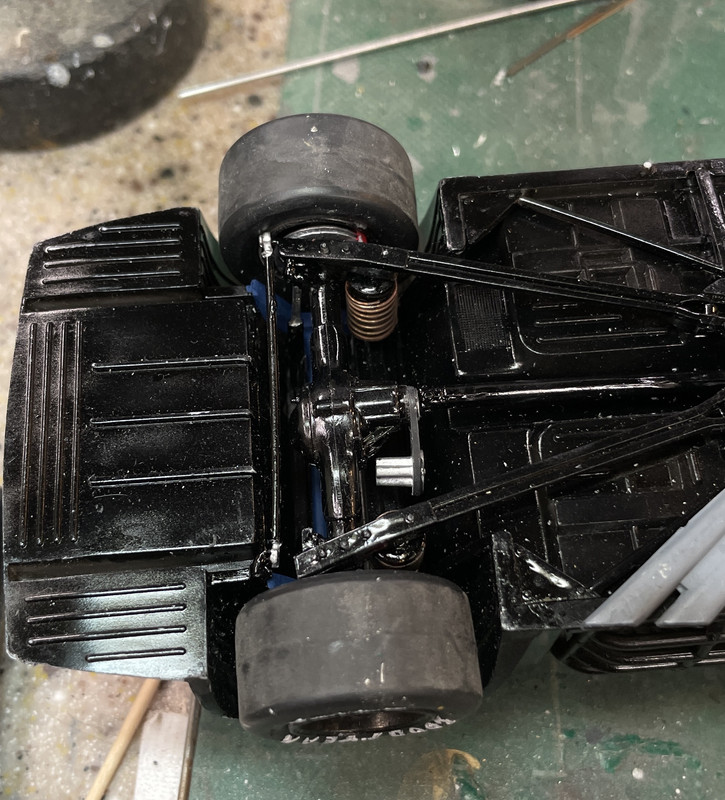
Next was the front end. My new brakes are still too big to nestle into the wheels. While I could have shaved off material from the calipers to get the to fit, I decided to use the original kit brake for the right wheel and will display the left wheel removed showing off the more detailed custom disc assembly.
I realized that attempting to install the springs and steering knuckles on both sides and THEN place on top of this the entire front end lower asssembly, I chose to install those that part first including the trapped shock absorbers first. The upper A-arm is very flexible (too flexible) and it will spread enough to insert the knuckle and attached brake. I’ll do that on Monday. The whole thing was stubborn to get settled in with some tension imposed by my custom springs, so I’m giving it the whole weekend to fully set.

And the underside:

The thing I did on the punch list was install the steering column. It probably should have gone in sooner, but it wasn’t much of problem.
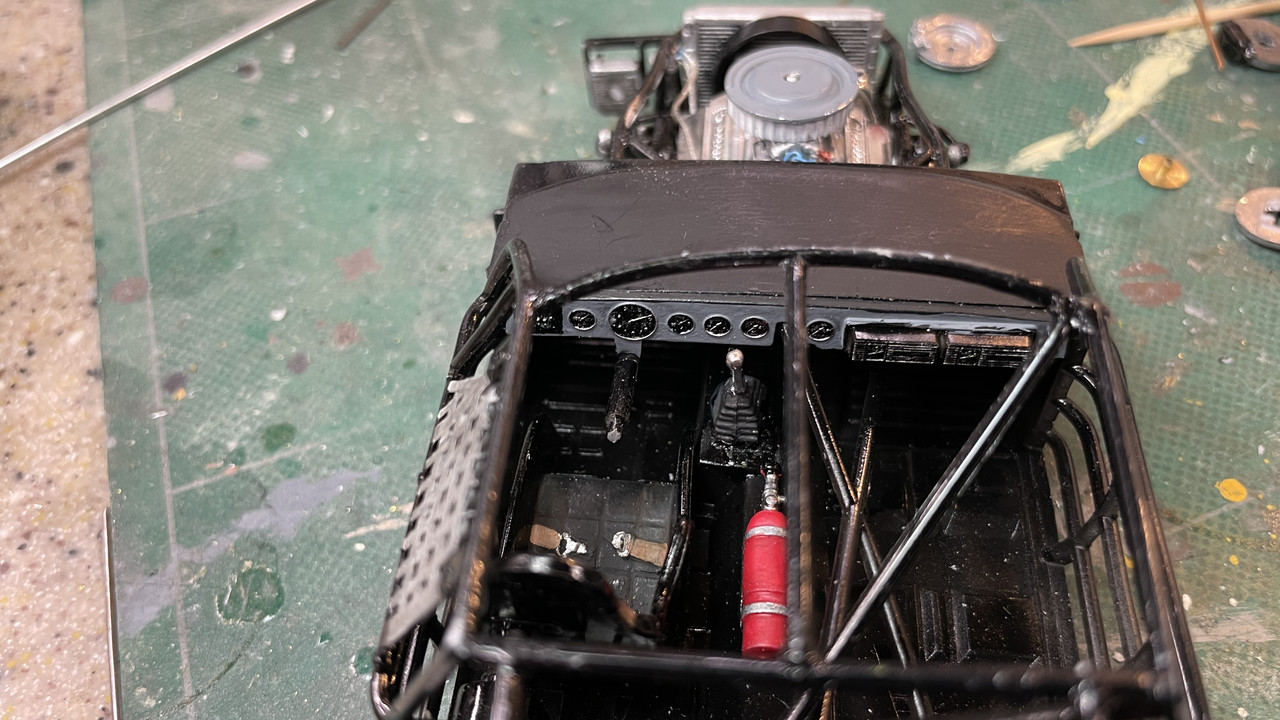
The front wheels and steering wheels are the last things to go in. And there’s the rear view mirror, which I may leave out since the mount is dubious at best. It will have to be wired to stay put.
She is looking good. ![]()
![]()
Thanks!
Put the first gloss coat on the body. And of course, before the Alclad AquaClear was fully cured, I dropped the darn thing on the floor (jelly side down) and it picked up some floor muck. Not much, just enough to make me grumpy.
I put the pieces under a cardboard box so it would fully cure without dust, but then I took the box off to check it, knocked the body holder which tipped over and dumped the model and hood onto the floor. DOH! Should have left it alone. My ADD rears its ugly head again.
Tomorrow I’m going to give it a light polishing and then apply one more coat. I then have to paint the front vents with a flat aluminum/steel color and the body should be finished.
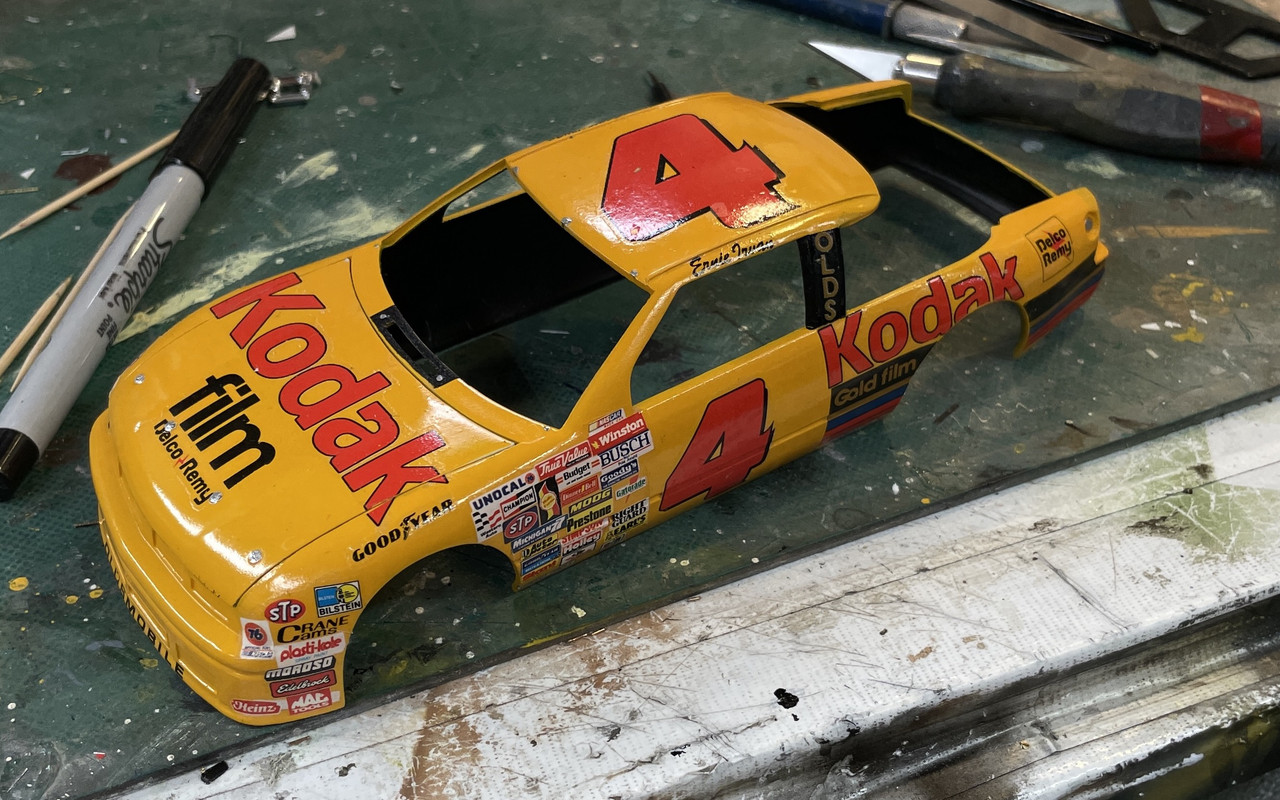
While that was drying I “attempted” to put on the front spindles and mount the tires. The “” are intentional. While fitting the two sides (one with the kit’s disc and the other with my custom one), the custom fell off. I spent the next 20 minutes sweeping, crawling, checking my clothing, etc. Nada, bubkis! I gave up and fabricated my own steering knuckle to fit nicely within my custom disc. I then used 0.032" phos-bronze wire as the king pin (even though modern cars use ball joints). This created a fully functional steering hub.
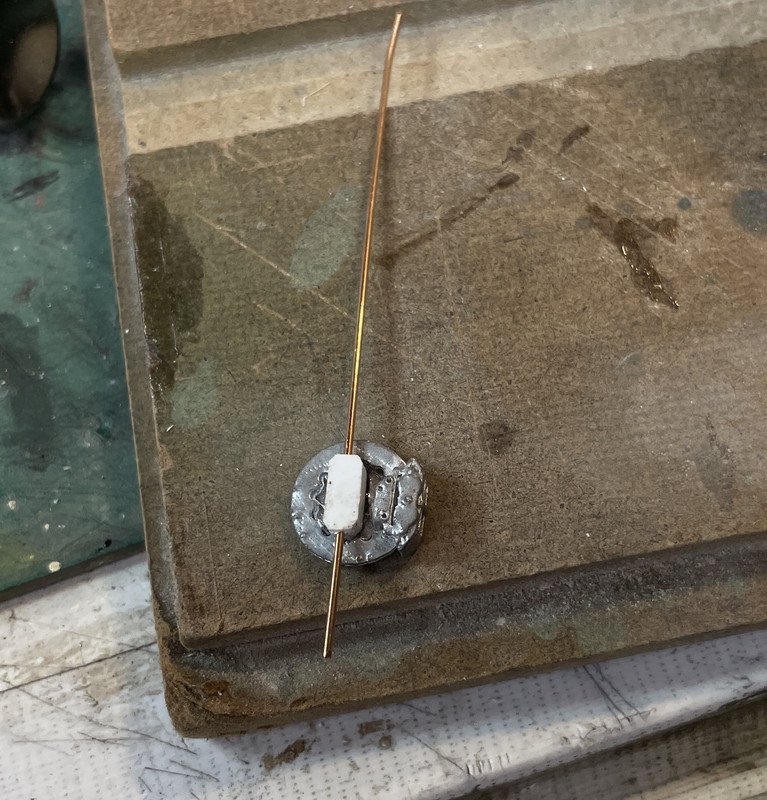
From the front I just CA’d the knuckle into place with medium CA and accelerator. After this image I painted the caliper bright red.
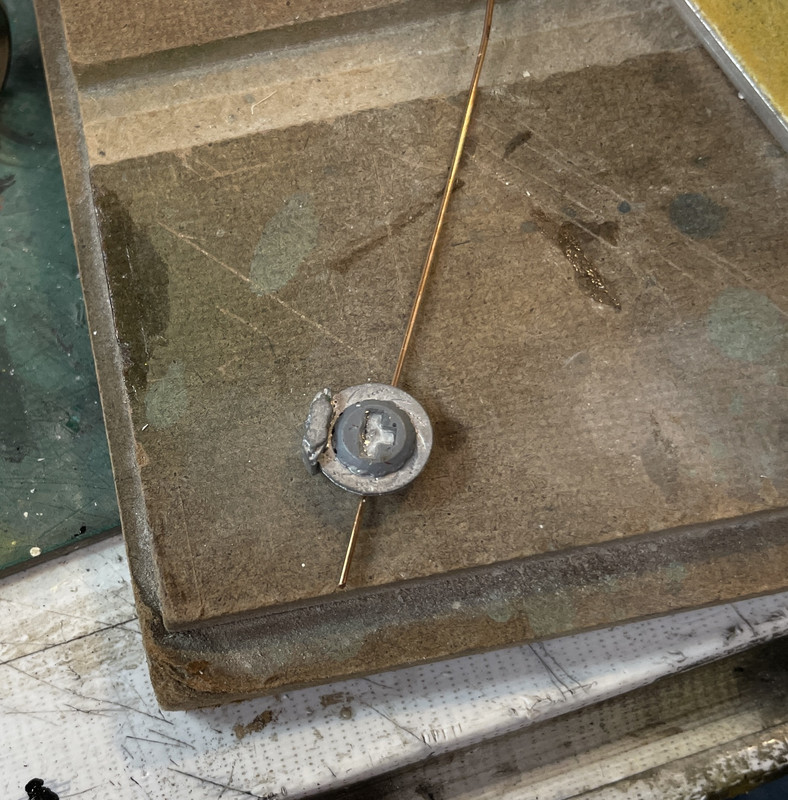
I drilled the upper and lower A-arms for the metal rod. I partially drilled the center to accept the steel pin I was using as an alxe (0.073"). I then installed it and clipped the excess metal sticking out. Wheels were glued with Gel CA and accelerator as the hole was a little larger than the pins.
The opposite side went on with the previously built kit parts. The new work is much sturdier.
During the handling I knocked off the radiator hose. I found it on the floor when searching for the steering part. It was a dubious joint to start with and was fixed with my usual method of pinning with some 0.022" wire.
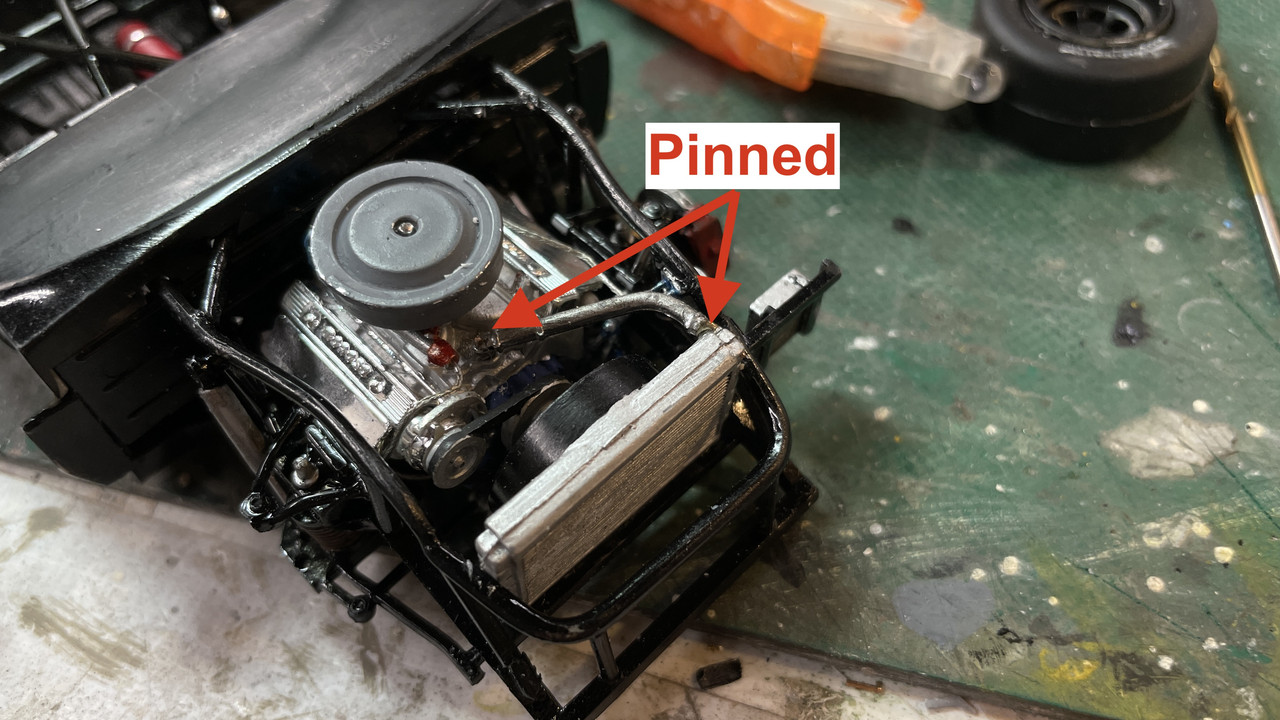
With the wheels installed it was time to take some complete chassis pictures. I also added the last part, the steering wheel.
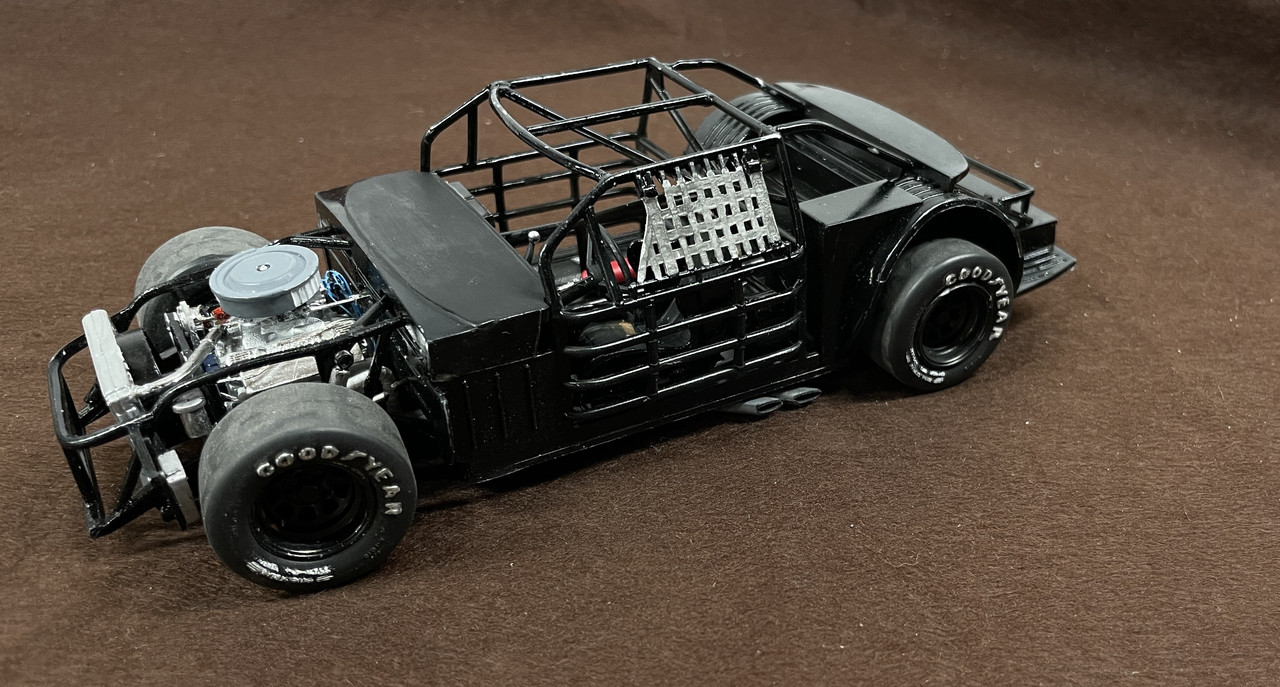
And the underside. It’s really not as dusty as these pictures seem to show.
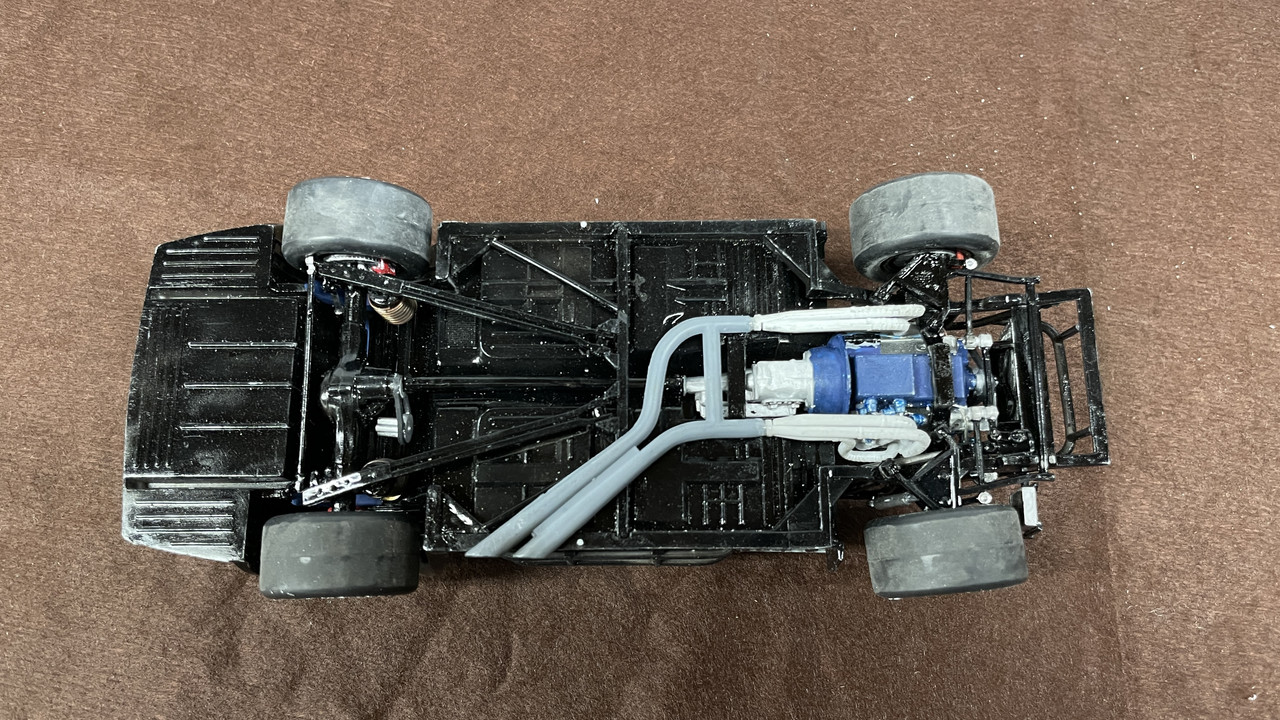
And then I ended the session and went upstairs to change out of my gross shop clothes, and looked what popped out on the closet floor.
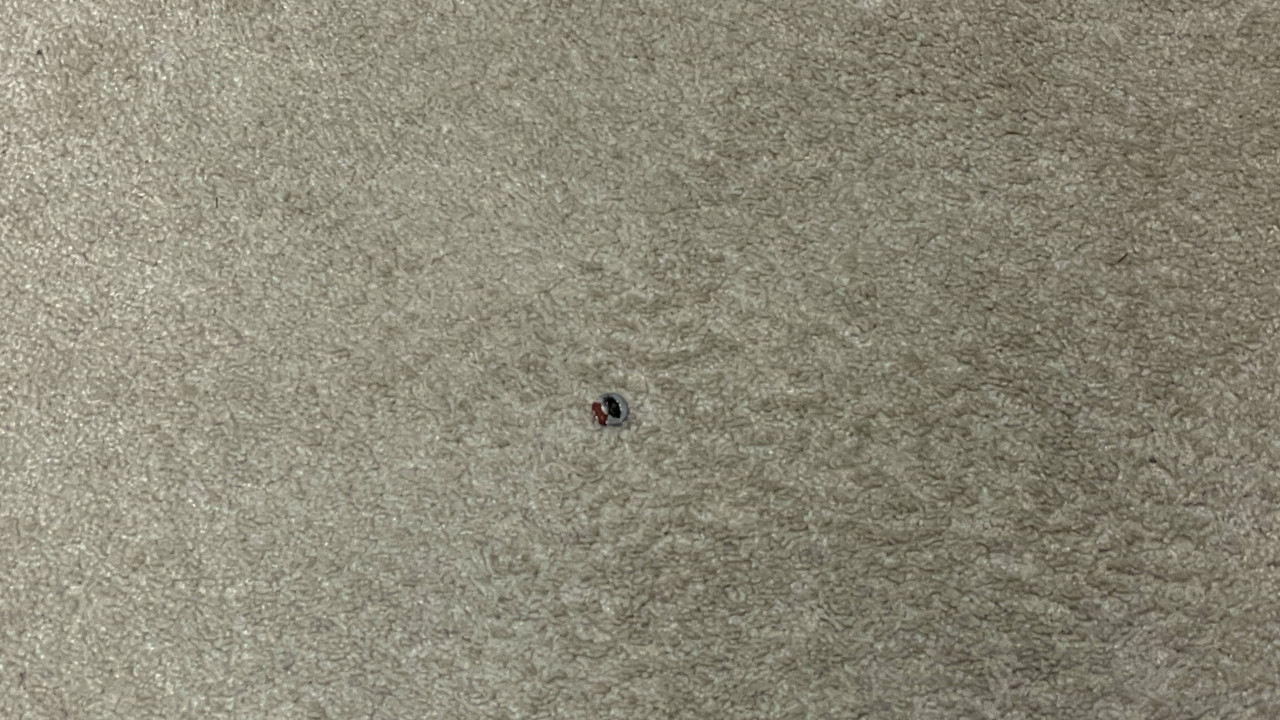
The *%)UY%@ part was hiding in my clothing anyway. I really did check my clothing and I don’t have cuffs. Furthermore, my flannel shirt is out, not tucked in, so it theoretically blocks parts creeping into my belt line. Not this part! This thing really was hiding. Too late! That ship had left the dock, was replaced and no longer needed.
